Applying Learning Theories to Counselling
VerifiedAdded on 2023/01/12
|23
|6193
|40
AI Summary
This assignment explores the application of learning theories to counselling. It covers classical conditioning, operant conditioning, and observational learning. It also discusses the use of these theories in behavioural change programs and the development of counselling resources.
Contribute Materials
Your contribution can guide someone’s learning journey. Share your
documents today.
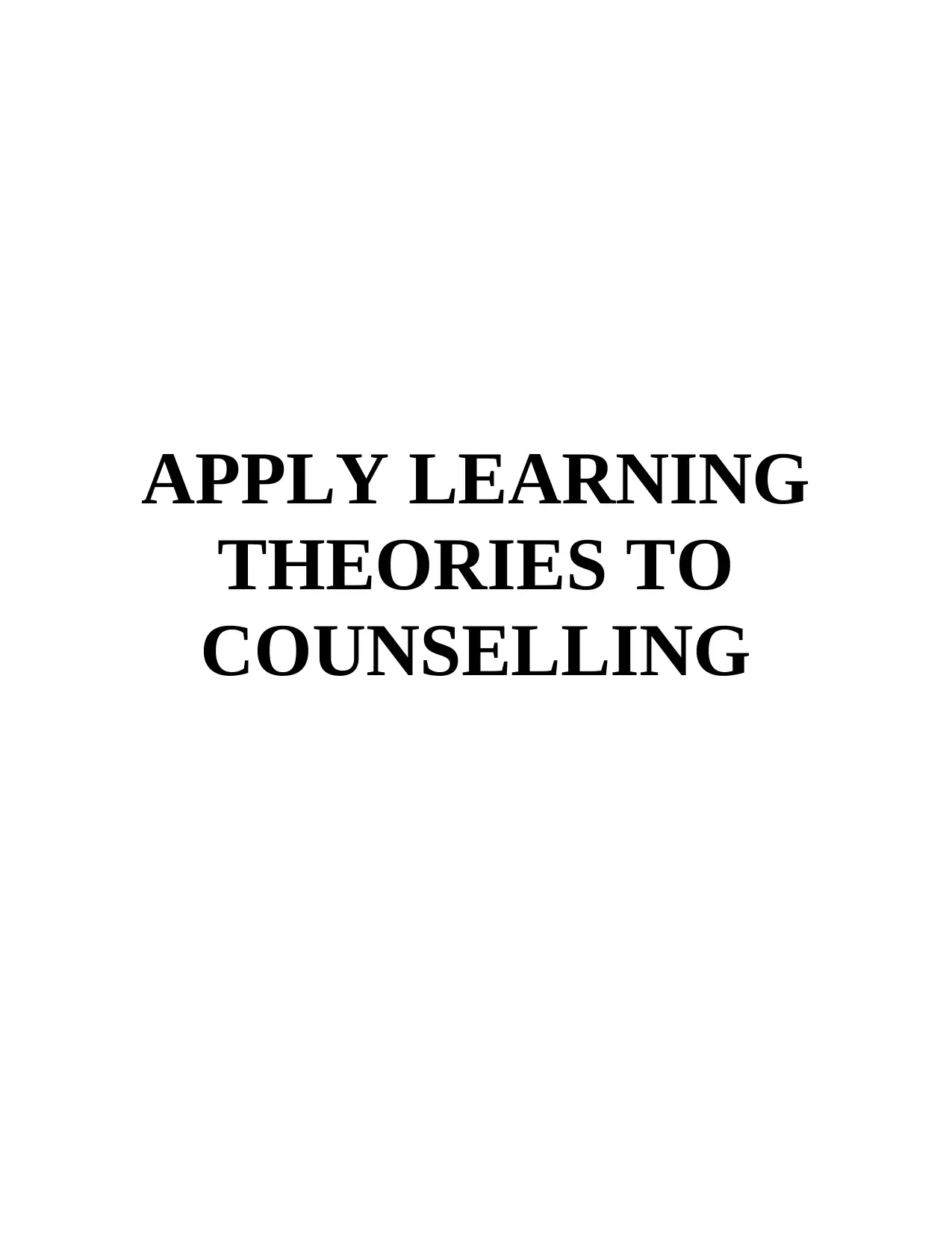
APPLY LEARNING
THEORIES TO
COUNSELLING
THEORIES TO
COUNSELLING
Secure Best Marks with AI Grader
Need help grading? Try our AI Grader for instant feedback on your assignments.
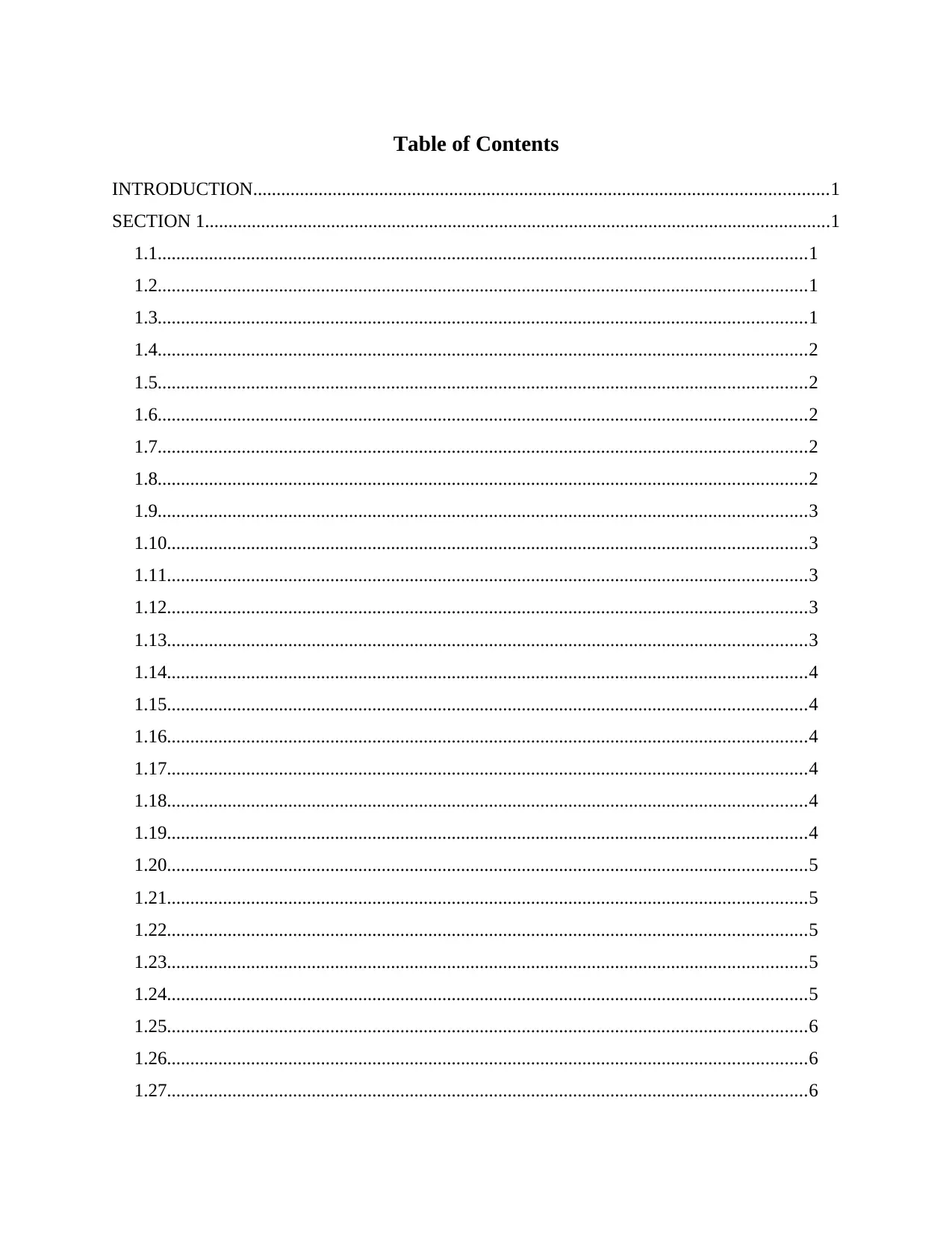
Table of Contents
INTRODUCTION...........................................................................................................................1
SECTION 1......................................................................................................................................1
1.1...........................................................................................................................................1
1.2...........................................................................................................................................1
1.3...........................................................................................................................................1
1.4...........................................................................................................................................2
1.5...........................................................................................................................................2
1.6...........................................................................................................................................2
1.7...........................................................................................................................................2
1.8...........................................................................................................................................2
1.9...........................................................................................................................................3
1.10.........................................................................................................................................3
1.11.........................................................................................................................................3
1.12.........................................................................................................................................3
1.13.........................................................................................................................................3
1.14.........................................................................................................................................4
1.15.........................................................................................................................................4
1.16.........................................................................................................................................4
1.17.........................................................................................................................................4
1.18.........................................................................................................................................4
1.19.........................................................................................................................................4
1.20.........................................................................................................................................5
1.21.........................................................................................................................................5
1.22.........................................................................................................................................5
1.23.........................................................................................................................................5
1.24.........................................................................................................................................5
1.25.........................................................................................................................................6
1.26.........................................................................................................................................6
1.27.........................................................................................................................................6
INTRODUCTION...........................................................................................................................1
SECTION 1......................................................................................................................................1
1.1...........................................................................................................................................1
1.2...........................................................................................................................................1
1.3...........................................................................................................................................1
1.4...........................................................................................................................................2
1.5...........................................................................................................................................2
1.6...........................................................................................................................................2
1.7...........................................................................................................................................2
1.8...........................................................................................................................................2
1.9...........................................................................................................................................3
1.10.........................................................................................................................................3
1.11.........................................................................................................................................3
1.12.........................................................................................................................................3
1.13.........................................................................................................................................3
1.14.........................................................................................................................................4
1.15.........................................................................................................................................4
1.16.........................................................................................................................................4
1.17.........................................................................................................................................4
1.18.........................................................................................................................................4
1.19.........................................................................................................................................4
1.20.........................................................................................................................................5
1.21.........................................................................................................................................5
1.22.........................................................................................................................................5
1.23.........................................................................................................................................5
1.24.........................................................................................................................................5
1.25.........................................................................................................................................6
1.26.........................................................................................................................................6
1.27.........................................................................................................................................6
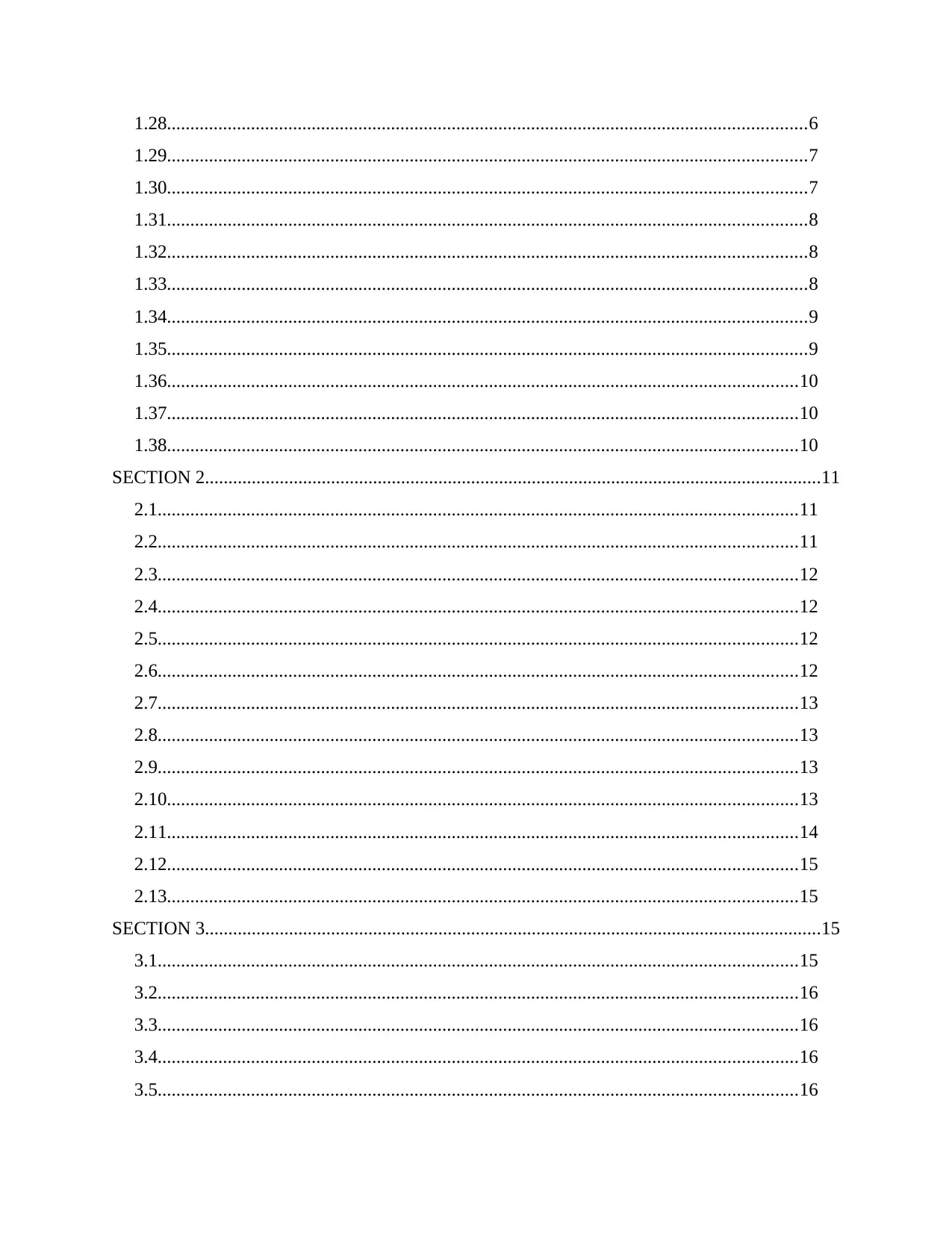
1.28.........................................................................................................................................6
1.29.........................................................................................................................................7
1.30.........................................................................................................................................7
1.31.........................................................................................................................................8
1.32.........................................................................................................................................8
1.33.........................................................................................................................................8
1.34.........................................................................................................................................9
1.35.........................................................................................................................................9
1.36.......................................................................................................................................10
1.37.......................................................................................................................................10
1.38.......................................................................................................................................10
SECTION 2....................................................................................................................................11
2.1.........................................................................................................................................11
2.2.........................................................................................................................................11
2.3.........................................................................................................................................12
2.4.........................................................................................................................................12
2.5.........................................................................................................................................12
2.6.........................................................................................................................................12
2.7.........................................................................................................................................13
2.8.........................................................................................................................................13
2.9.........................................................................................................................................13
2.10.......................................................................................................................................13
2.11.......................................................................................................................................14
2.12.......................................................................................................................................15
2.13.......................................................................................................................................15
SECTION 3....................................................................................................................................15
3.1.........................................................................................................................................15
3.2.........................................................................................................................................16
3.3.........................................................................................................................................16
3.4.........................................................................................................................................16
3.5.........................................................................................................................................16
1.29.........................................................................................................................................7
1.30.........................................................................................................................................7
1.31.........................................................................................................................................8
1.32.........................................................................................................................................8
1.33.........................................................................................................................................8
1.34.........................................................................................................................................9
1.35.........................................................................................................................................9
1.36.......................................................................................................................................10
1.37.......................................................................................................................................10
1.38.......................................................................................................................................10
SECTION 2....................................................................................................................................11
2.1.........................................................................................................................................11
2.2.........................................................................................................................................11
2.3.........................................................................................................................................12
2.4.........................................................................................................................................12
2.5.........................................................................................................................................12
2.6.........................................................................................................................................12
2.7.........................................................................................................................................13
2.8.........................................................................................................................................13
2.9.........................................................................................................................................13
2.10.......................................................................................................................................13
2.11.......................................................................................................................................14
2.12.......................................................................................................................................15
2.13.......................................................................................................................................15
SECTION 3....................................................................................................................................15
3.1.........................................................................................................................................15
3.2.........................................................................................................................................16
3.3.........................................................................................................................................16
3.4.........................................................................................................................................16
3.5.........................................................................................................................................16
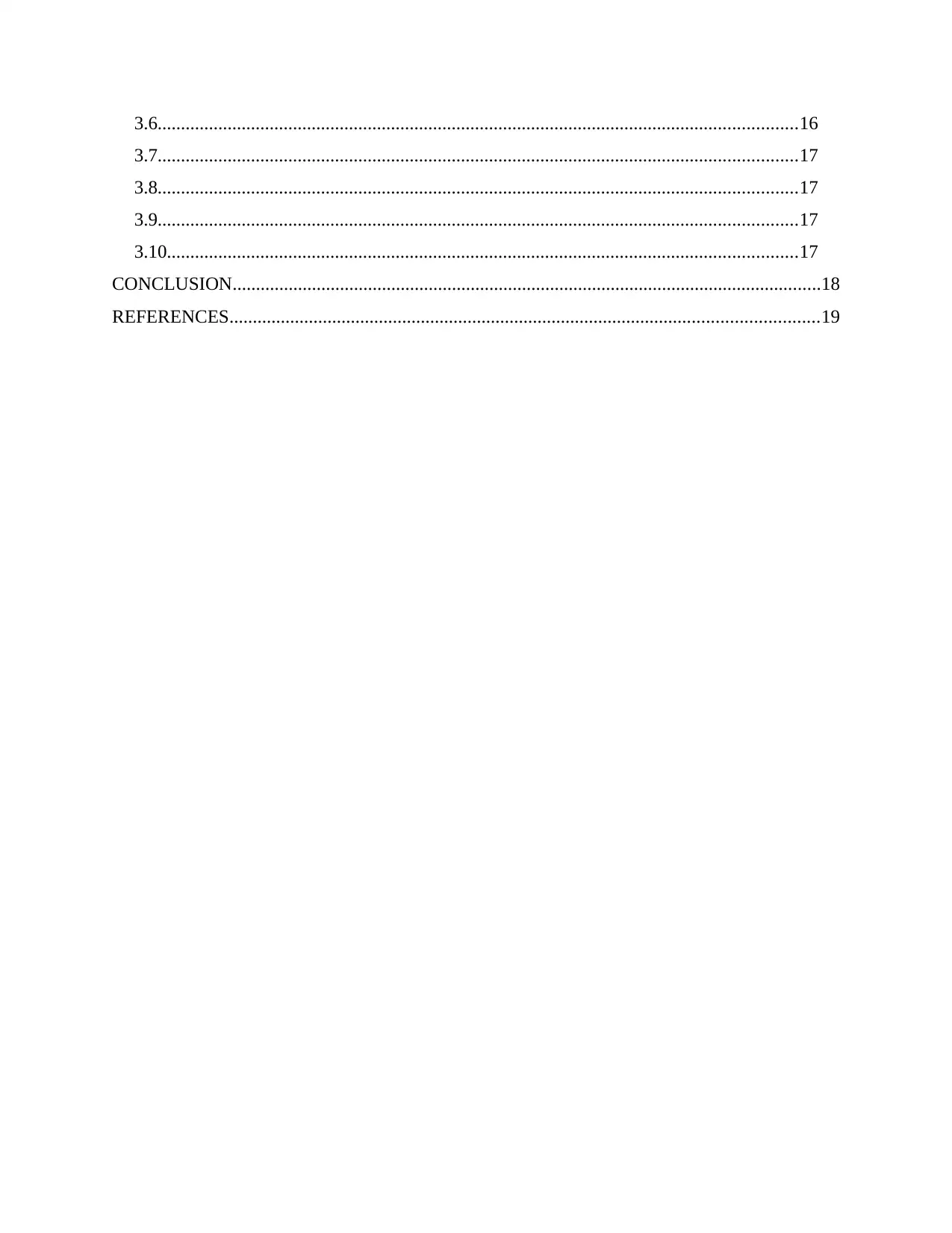
3.6.........................................................................................................................................16
3.7.........................................................................................................................................17
3.8.........................................................................................................................................17
3.9.........................................................................................................................................17
3.10.......................................................................................................................................17
CONCLUSION..............................................................................................................................18
REFERENCES..............................................................................................................................19
3.7.........................................................................................................................................17
3.8.........................................................................................................................................17
3.9.........................................................................................................................................17
3.10.......................................................................................................................................17
CONCLUSION..............................................................................................................................18
REFERENCES..............................................................................................................................19
Paraphrase This Document
Need a fresh take? Get an instant paraphrase of this document with our AI Paraphraser
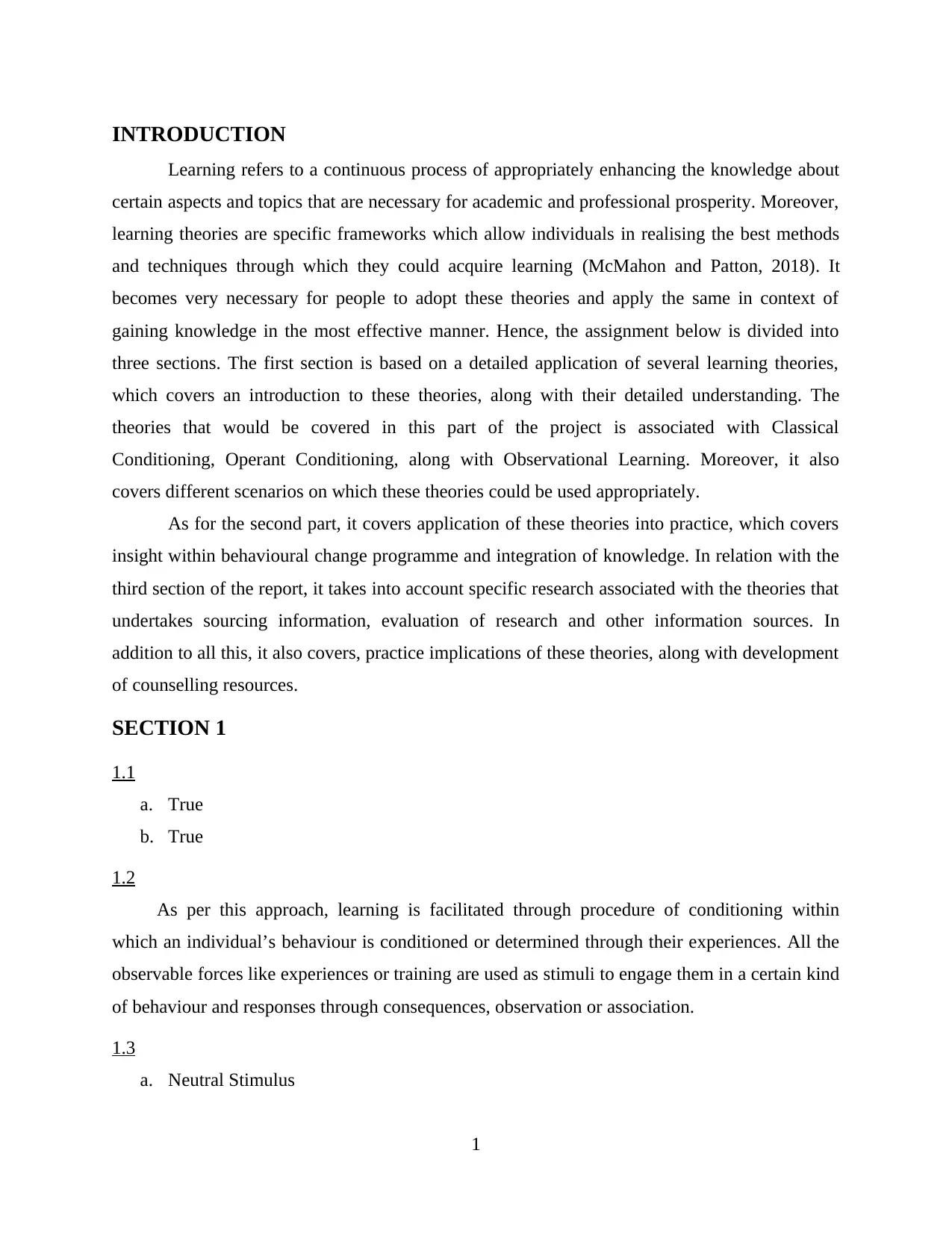
INTRODUCTION
Learning refers to a continuous process of appropriately enhancing the knowledge about
certain aspects and topics that are necessary for academic and professional prosperity. Moreover,
learning theories are specific frameworks which allow individuals in realising the best methods
and techniques through which they could acquire learning (McMahon and Patton, 2018). It
becomes very necessary for people to adopt these theories and apply the same in context of
gaining knowledge in the most effective manner. Hence, the assignment below is divided into
three sections. The first section is based on a detailed application of several learning theories,
which covers an introduction to these theories, along with their detailed understanding. The
theories that would be covered in this part of the project is associated with Classical
Conditioning, Operant Conditioning, along with Observational Learning. Moreover, it also
covers different scenarios on which these theories could be used appropriately.
As for the second part, it covers application of these theories into practice, which covers
insight within behavioural change programme and integration of knowledge. In relation with the
third section of the report, it takes into account specific research associated with the theories that
undertakes sourcing information, evaluation of research and other information sources. In
addition to all this, it also covers, practice implications of these theories, along with development
of counselling resources.
SECTION 1
1.1
a. True
b. True
1.2
As per this approach, learning is facilitated through procedure of conditioning within
which an individual’s behaviour is conditioned or determined through their experiences. All the
observable forces like experiences or training are used as stimuli to engage them in a certain kind
of behaviour and responses through consequences, observation or association.
1.3
a. Neutral Stimulus
1
Learning refers to a continuous process of appropriately enhancing the knowledge about
certain aspects and topics that are necessary for academic and professional prosperity. Moreover,
learning theories are specific frameworks which allow individuals in realising the best methods
and techniques through which they could acquire learning (McMahon and Patton, 2018). It
becomes very necessary for people to adopt these theories and apply the same in context of
gaining knowledge in the most effective manner. Hence, the assignment below is divided into
three sections. The first section is based on a detailed application of several learning theories,
which covers an introduction to these theories, along with their detailed understanding. The
theories that would be covered in this part of the project is associated with Classical
Conditioning, Operant Conditioning, along with Observational Learning. Moreover, it also
covers different scenarios on which these theories could be used appropriately.
As for the second part, it covers application of these theories into practice, which covers
insight within behavioural change programme and integration of knowledge. In relation with the
third section of the report, it takes into account specific research associated with the theories that
undertakes sourcing information, evaluation of research and other information sources. In
addition to all this, it also covers, practice implications of these theories, along with development
of counselling resources.
SECTION 1
1.1
a. True
b. True
1.2
As per this approach, learning is facilitated through procedure of conditioning within
which an individual’s behaviour is conditioned or determined through their experiences. All the
observable forces like experiences or training are used as stimuli to engage them in a certain kind
of behaviour and responses through consequences, observation or association.
1.3
a. Neutral Stimulus
1
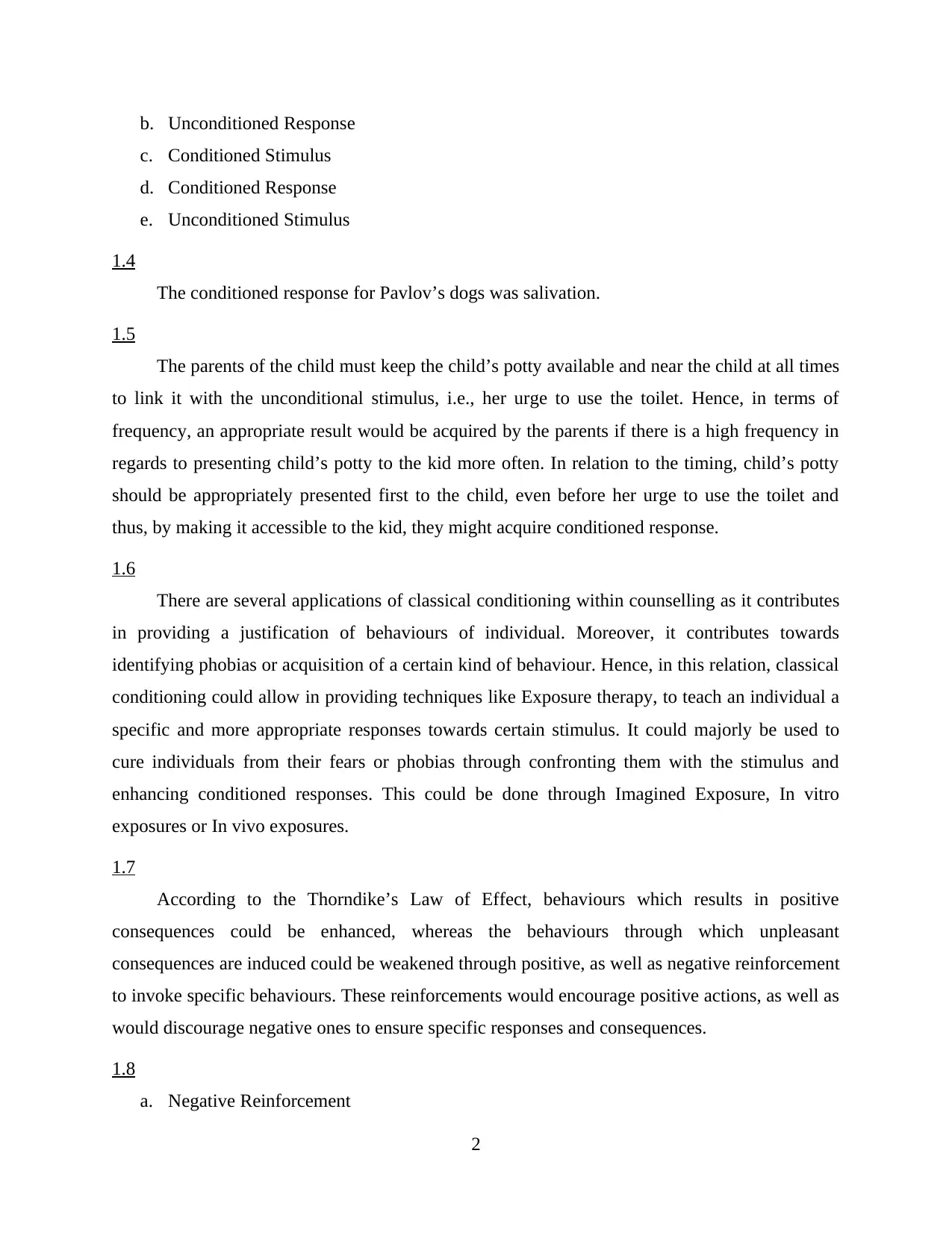
b. Unconditioned Response
c. Conditioned Stimulus
d. Conditioned Response
e. Unconditioned Stimulus
1.4
The conditioned response for Pavlov’s dogs was salivation.
1.5
The parents of the child must keep the child’s potty available and near the child at all times
to link it with the unconditional stimulus, i.e., her urge to use the toilet. Hence, in terms of
frequency, an appropriate result would be acquired by the parents if there is a high frequency in
regards to presenting child’s potty to the kid more often. In relation to the timing, child’s potty
should be appropriately presented first to the child, even before her urge to use the toilet and
thus, by making it accessible to the kid, they might acquire conditioned response.
1.6
There are several applications of classical conditioning within counselling as it contributes
in providing a justification of behaviours of individual. Moreover, it contributes towards
identifying phobias or acquisition of a certain kind of behaviour. Hence, in this relation, classical
conditioning could allow in providing techniques like Exposure therapy, to teach an individual a
specific and more appropriate responses towards certain stimulus. It could majorly be used to
cure individuals from their fears or phobias through confronting them with the stimulus and
enhancing conditioned responses. This could be done through Imagined Exposure, In vitro
exposures or In vivo exposures.
1.7
According to the Thorndike’s Law of Effect, behaviours which results in positive
consequences could be enhanced, whereas the behaviours through which unpleasant
consequences are induced could be weakened through positive, as well as negative reinforcement
to invoke specific behaviours. These reinforcements would encourage positive actions, as well as
would discourage negative ones to ensure specific responses and consequences.
1.8
a. Negative Reinforcement
2
c. Conditioned Stimulus
d. Conditioned Response
e. Unconditioned Stimulus
1.4
The conditioned response for Pavlov’s dogs was salivation.
1.5
The parents of the child must keep the child’s potty available and near the child at all times
to link it with the unconditional stimulus, i.e., her urge to use the toilet. Hence, in terms of
frequency, an appropriate result would be acquired by the parents if there is a high frequency in
regards to presenting child’s potty to the kid more often. In relation to the timing, child’s potty
should be appropriately presented first to the child, even before her urge to use the toilet and
thus, by making it accessible to the kid, they might acquire conditioned response.
1.6
There are several applications of classical conditioning within counselling as it contributes
in providing a justification of behaviours of individual. Moreover, it contributes towards
identifying phobias or acquisition of a certain kind of behaviour. Hence, in this relation, classical
conditioning could allow in providing techniques like Exposure therapy, to teach an individual a
specific and more appropriate responses towards certain stimulus. It could majorly be used to
cure individuals from their fears or phobias through confronting them with the stimulus and
enhancing conditioned responses. This could be done through Imagined Exposure, In vitro
exposures or In vivo exposures.
1.7
According to the Thorndike’s Law of Effect, behaviours which results in positive
consequences could be enhanced, whereas the behaviours through which unpleasant
consequences are induced could be weakened through positive, as well as negative reinforcement
to invoke specific behaviours. These reinforcements would encourage positive actions, as well as
would discourage negative ones to ensure specific responses and consequences.
1.8
a. Negative Reinforcement
2
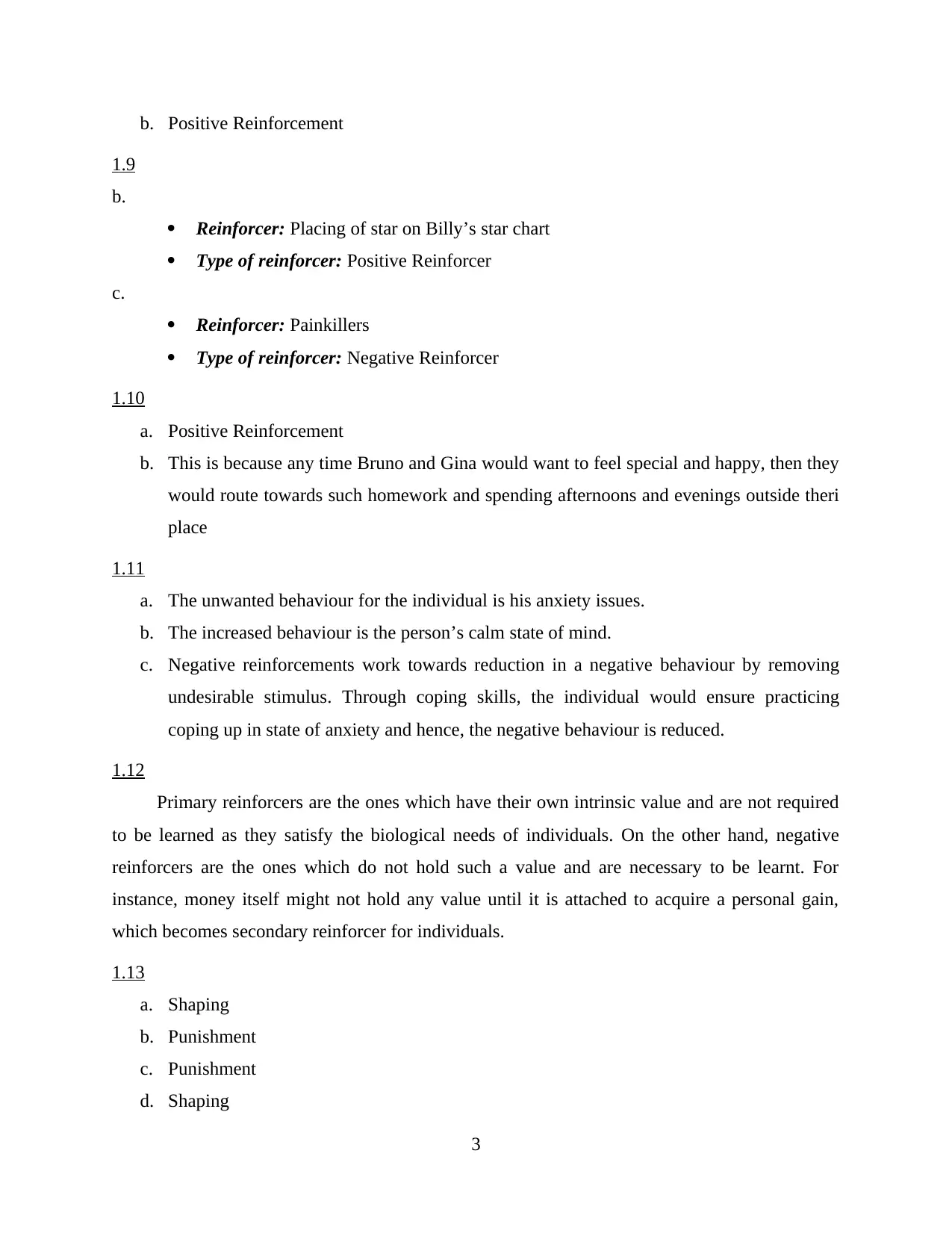
b. Positive Reinforcement
1.9
b.
Reinforcer: Placing of star on Billy’s star chart
Type of reinforcer: Positive Reinforcer
c.
Reinforcer: Painkillers
Type of reinforcer: Negative Reinforcer
1.10
a. Positive Reinforcement
b. This is because any time Bruno and Gina would want to feel special and happy, then they
would route towards such homework and spending afternoons and evenings outside theri
place
1.11
a. The unwanted behaviour for the individual is his anxiety issues.
b. The increased behaviour is the person’s calm state of mind.
c. Negative reinforcements work towards reduction in a negative behaviour by removing
undesirable stimulus. Through coping skills, the individual would ensure practicing
coping up in state of anxiety and hence, the negative behaviour is reduced.
1.12
Primary reinforcers are the ones which have their own intrinsic value and are not required
to be learned as they satisfy the biological needs of individuals. On the other hand, negative
reinforcers are the ones which do not hold such a value and are necessary to be learnt. For
instance, money itself might not hold any value until it is attached to acquire a personal gain,
which becomes secondary reinforcer for individuals.
1.13
a. Shaping
b. Punishment
c. Punishment
d. Shaping
3
1.9
b.
Reinforcer: Placing of star on Billy’s star chart
Type of reinforcer: Positive Reinforcer
c.
Reinforcer: Painkillers
Type of reinforcer: Negative Reinforcer
1.10
a. Positive Reinforcement
b. This is because any time Bruno and Gina would want to feel special and happy, then they
would route towards such homework and spending afternoons and evenings outside theri
place
1.11
a. The unwanted behaviour for the individual is his anxiety issues.
b. The increased behaviour is the person’s calm state of mind.
c. Negative reinforcements work towards reduction in a negative behaviour by removing
undesirable stimulus. Through coping skills, the individual would ensure practicing
coping up in state of anxiety and hence, the negative behaviour is reduced.
1.12
Primary reinforcers are the ones which have their own intrinsic value and are not required
to be learned as they satisfy the biological needs of individuals. On the other hand, negative
reinforcers are the ones which do not hold such a value and are necessary to be learnt. For
instance, money itself might not hold any value until it is attached to acquire a personal gain,
which becomes secondary reinforcer for individuals.
1.13
a. Shaping
b. Punishment
c. Punishment
d. Shaping
3
Secure Best Marks with AI Grader
Need help grading? Try our AI Grader for instant feedback on your assignments.
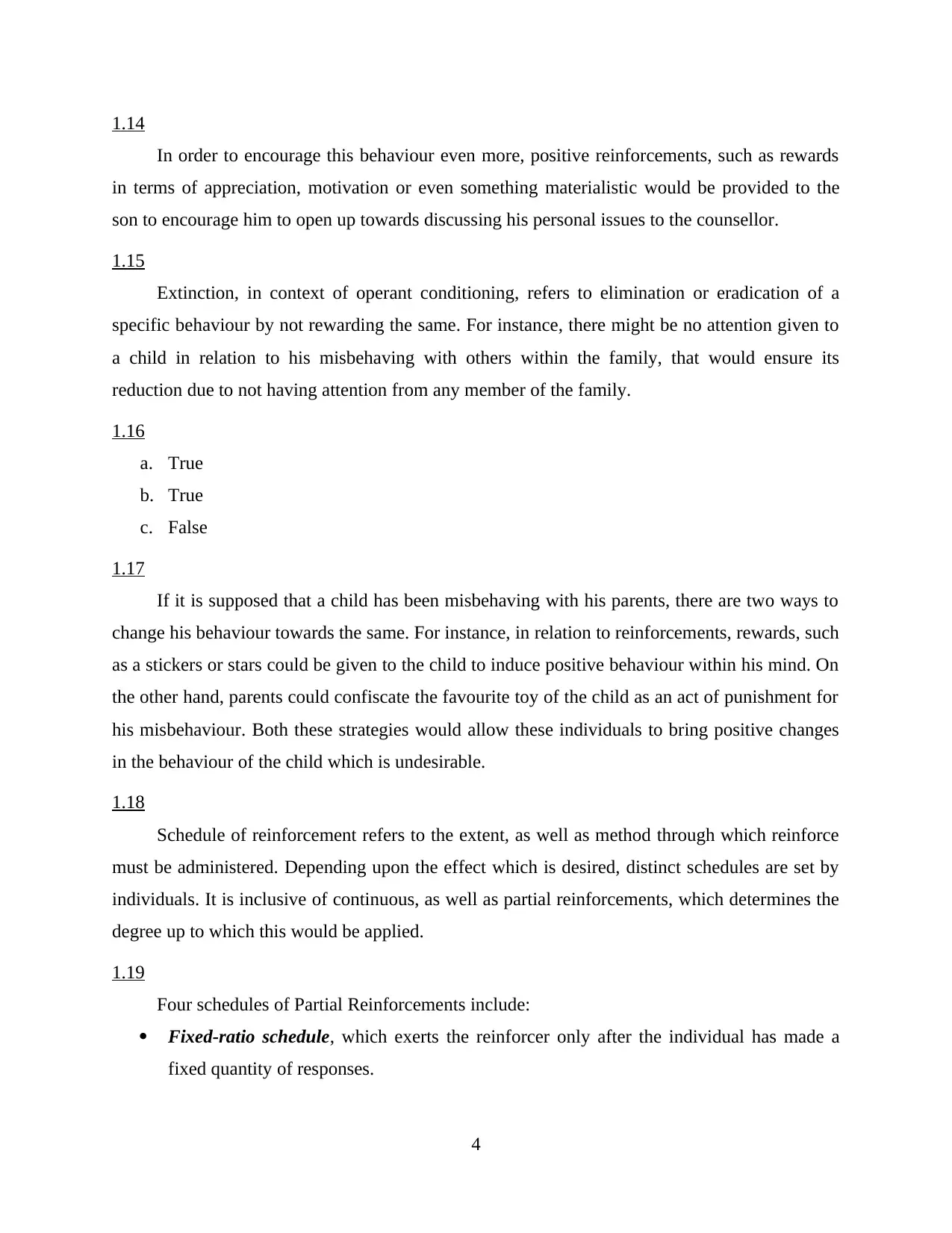
1.14
In order to encourage this behaviour even more, positive reinforcements, such as rewards
in terms of appreciation, motivation or even something materialistic would be provided to the
son to encourage him to open up towards discussing his personal issues to the counsellor.
1.15
Extinction, in context of operant conditioning, refers to elimination or eradication of a
specific behaviour by not rewarding the same. For instance, there might be no attention given to
a child in relation to his misbehaving with others within the family, that would ensure its
reduction due to not having attention from any member of the family.
1.16
a. True
b. True
c. False
1.17
If it is supposed that a child has been misbehaving with his parents, there are two ways to
change his behaviour towards the same. For instance, in relation to reinforcements, rewards, such
as a stickers or stars could be given to the child to induce positive behaviour within his mind. On
the other hand, parents could confiscate the favourite toy of the child as an act of punishment for
his misbehaviour. Both these strategies would allow these individuals to bring positive changes
in the behaviour of the child which is undesirable.
1.18
Schedule of reinforcement refers to the extent, as well as method through which reinforce
must be administered. Depending upon the effect which is desired, distinct schedules are set by
individuals. It is inclusive of continuous, as well as partial reinforcements, which determines the
degree up to which this would be applied.
1.19
Four schedules of Partial Reinforcements include:
Fixed-ratio schedule, which exerts the reinforcer only after the individual has made a
fixed quantity of responses.
4
In order to encourage this behaviour even more, positive reinforcements, such as rewards
in terms of appreciation, motivation or even something materialistic would be provided to the
son to encourage him to open up towards discussing his personal issues to the counsellor.
1.15
Extinction, in context of operant conditioning, refers to elimination or eradication of a
specific behaviour by not rewarding the same. For instance, there might be no attention given to
a child in relation to his misbehaving with others within the family, that would ensure its
reduction due to not having attention from any member of the family.
1.16
a. True
b. True
c. False
1.17
If it is supposed that a child has been misbehaving with his parents, there are two ways to
change his behaviour towards the same. For instance, in relation to reinforcements, rewards, such
as a stickers or stars could be given to the child to induce positive behaviour within his mind. On
the other hand, parents could confiscate the favourite toy of the child as an act of punishment for
his misbehaviour. Both these strategies would allow these individuals to bring positive changes
in the behaviour of the child which is undesirable.
1.18
Schedule of reinforcement refers to the extent, as well as method through which reinforce
must be administered. Depending upon the effect which is desired, distinct schedules are set by
individuals. It is inclusive of continuous, as well as partial reinforcements, which determines the
degree up to which this would be applied.
1.19
Four schedules of Partial Reinforcements include:
Fixed-ratio schedule, which exerts the reinforcer only after the individual has made a
fixed quantity of responses.
4
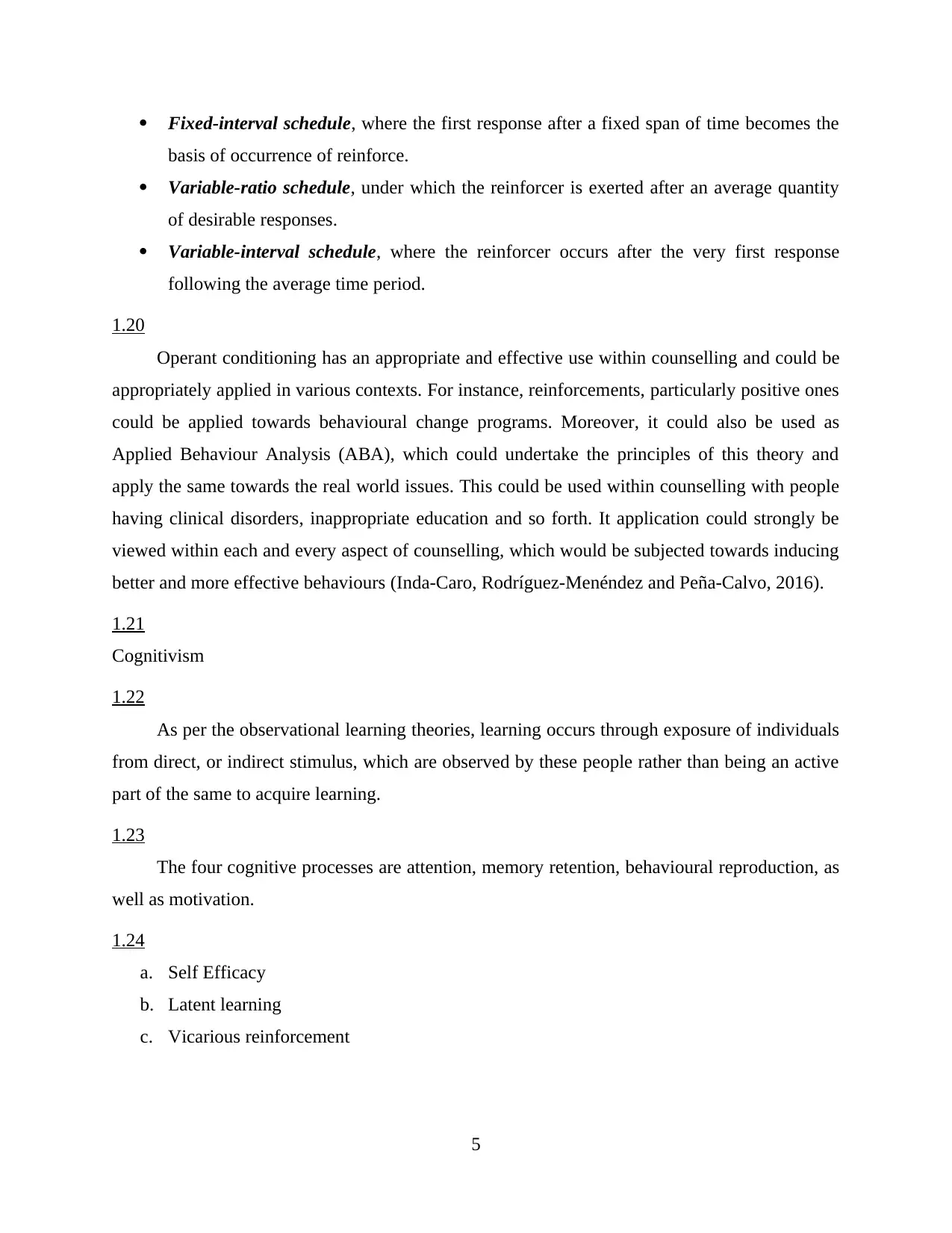
Fixed-interval schedule, where the first response after a fixed span of time becomes the
basis of occurrence of reinforce.
Variable-ratio schedule, under which the reinforcer is exerted after an average quantity
of desirable responses.
Variable-interval schedule, where the reinforcer occurs after the very first response
following the average time period.
1.20
Operant conditioning has an appropriate and effective use within counselling and could be
appropriately applied in various contexts. For instance, reinforcements, particularly positive ones
could be applied towards behavioural change programs. Moreover, it could also be used as
Applied Behaviour Analysis (ABA), which could undertake the principles of this theory and
apply the same towards the real world issues. This could be used within counselling with people
having clinical disorders, inappropriate education and so forth. It application could strongly be
viewed within each and every aspect of counselling, which would be subjected towards inducing
better and more effective behaviours (Inda-Caro, Rodríguez-Menéndez and Peña-Calvo, 2016).
1.21
Cognitivism
1.22
As per the observational learning theories, learning occurs through exposure of individuals
from direct, or indirect stimulus, which are observed by these people rather than being an active
part of the same to acquire learning.
1.23
The four cognitive processes are attention, memory retention, behavioural reproduction, as
well as motivation.
1.24
a. Self Efficacy
b. Latent learning
c. Vicarious reinforcement
5
basis of occurrence of reinforce.
Variable-ratio schedule, under which the reinforcer is exerted after an average quantity
of desirable responses.
Variable-interval schedule, where the reinforcer occurs after the very first response
following the average time period.
1.20
Operant conditioning has an appropriate and effective use within counselling and could be
appropriately applied in various contexts. For instance, reinforcements, particularly positive ones
could be applied towards behavioural change programs. Moreover, it could also be used as
Applied Behaviour Analysis (ABA), which could undertake the principles of this theory and
apply the same towards the real world issues. This could be used within counselling with people
having clinical disorders, inappropriate education and so forth. It application could strongly be
viewed within each and every aspect of counselling, which would be subjected towards inducing
better and more effective behaviours (Inda-Caro, Rodríguez-Menéndez and Peña-Calvo, 2016).
1.21
Cognitivism
1.22
As per the observational learning theories, learning occurs through exposure of individuals
from direct, or indirect stimulus, which are observed by these people rather than being an active
part of the same to acquire learning.
1.23
The four cognitive processes are attention, memory retention, behavioural reproduction, as
well as motivation.
1.24
a. Self Efficacy
b. Latent learning
c. Vicarious reinforcement
5
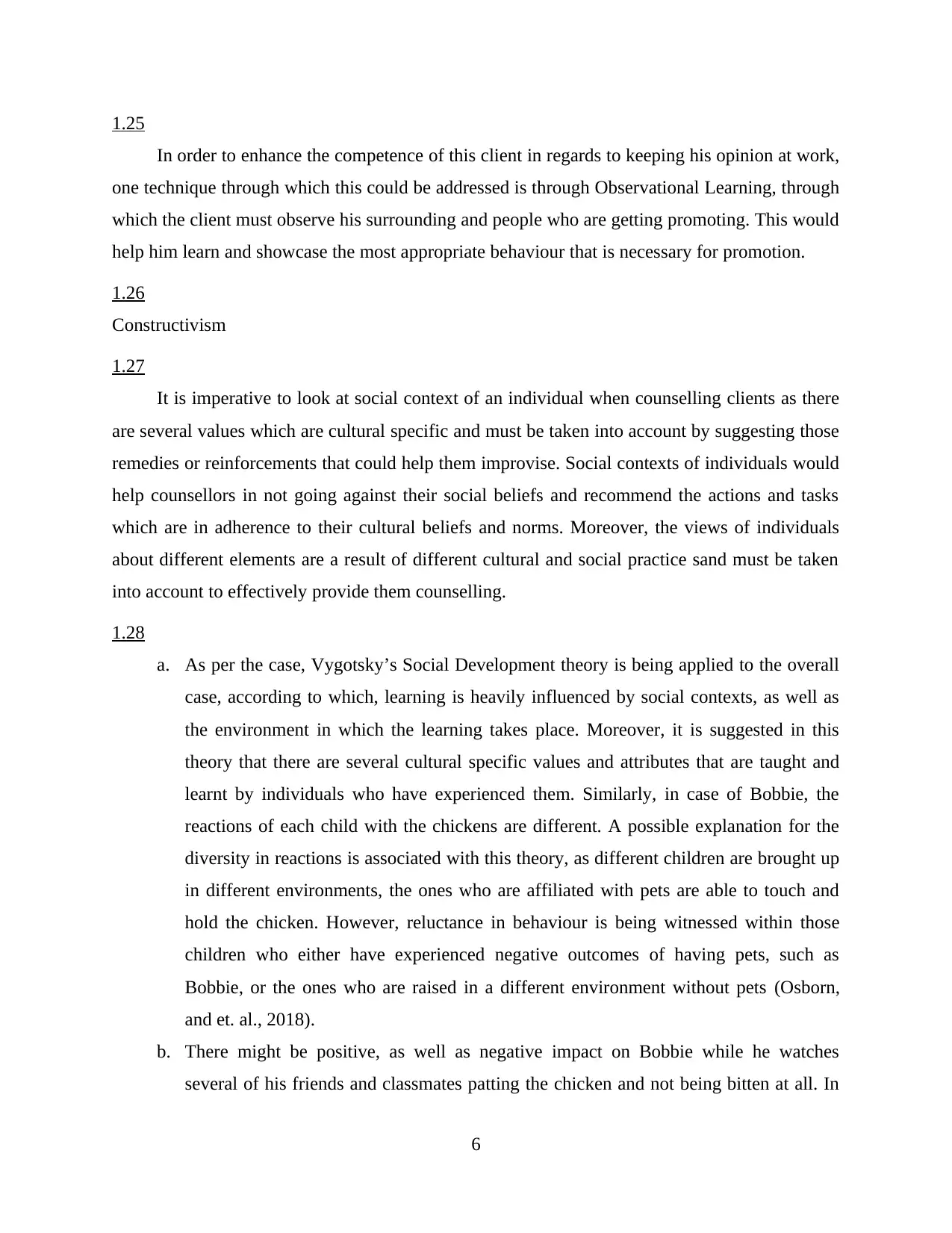
1.25
In order to enhance the competence of this client in regards to keeping his opinion at work,
one technique through which this could be addressed is through Observational Learning, through
which the client must observe his surrounding and people who are getting promoting. This would
help him learn and showcase the most appropriate behaviour that is necessary for promotion.
1.26
Constructivism
1.27
It is imperative to look at social context of an individual when counselling clients as there
are several values which are cultural specific and must be taken into account by suggesting those
remedies or reinforcements that could help them improvise. Social contexts of individuals would
help counsellors in not going against their social beliefs and recommend the actions and tasks
which are in adherence to their cultural beliefs and norms. Moreover, the views of individuals
about different elements are a result of different cultural and social practice sand must be taken
into account to effectively provide them counselling.
1.28
a. As per the case, Vygotsky’s Social Development theory is being applied to the overall
case, according to which, learning is heavily influenced by social contexts, as well as
the environment in which the learning takes place. Moreover, it is suggested in this
theory that there are several cultural specific values and attributes that are taught and
learnt by individuals who have experienced them. Similarly, in case of Bobbie, the
reactions of each child with the chickens are different. A possible explanation for the
diversity in reactions is associated with this theory, as different children are brought up
in different environments, the ones who are affiliated with pets are able to touch and
hold the chicken. However, reluctance in behaviour is being witnessed within those
children who either have experienced negative outcomes of having pets, such as
Bobbie, or the ones who are raised in a different environment without pets (Osborn,
and et. al., 2018).
b. There might be positive, as well as negative impact on Bobbie while he watches
several of his friends and classmates patting the chicken and not being bitten at all. In
6
In order to enhance the competence of this client in regards to keeping his opinion at work,
one technique through which this could be addressed is through Observational Learning, through
which the client must observe his surrounding and people who are getting promoting. This would
help him learn and showcase the most appropriate behaviour that is necessary for promotion.
1.26
Constructivism
1.27
It is imperative to look at social context of an individual when counselling clients as there
are several values which are cultural specific and must be taken into account by suggesting those
remedies or reinforcements that could help them improvise. Social contexts of individuals would
help counsellors in not going against their social beliefs and recommend the actions and tasks
which are in adherence to their cultural beliefs and norms. Moreover, the views of individuals
about different elements are a result of different cultural and social practice sand must be taken
into account to effectively provide them counselling.
1.28
a. As per the case, Vygotsky’s Social Development theory is being applied to the overall
case, according to which, learning is heavily influenced by social contexts, as well as
the environment in which the learning takes place. Moreover, it is suggested in this
theory that there are several cultural specific values and attributes that are taught and
learnt by individuals who have experienced them. Similarly, in case of Bobbie, the
reactions of each child with the chickens are different. A possible explanation for the
diversity in reactions is associated with this theory, as different children are brought up
in different environments, the ones who are affiliated with pets are able to touch and
hold the chicken. However, reluctance in behaviour is being witnessed within those
children who either have experienced negative outcomes of having pets, such as
Bobbie, or the ones who are raised in a different environment without pets (Osborn,
and et. al., 2018).
b. There might be positive, as well as negative impact on Bobbie while he watches
several of his friends and classmates patting the chicken and not being bitten at all. In
6
Paraphrase This Document
Need a fresh take? Get an instant paraphrase of this document with our AI Paraphraser
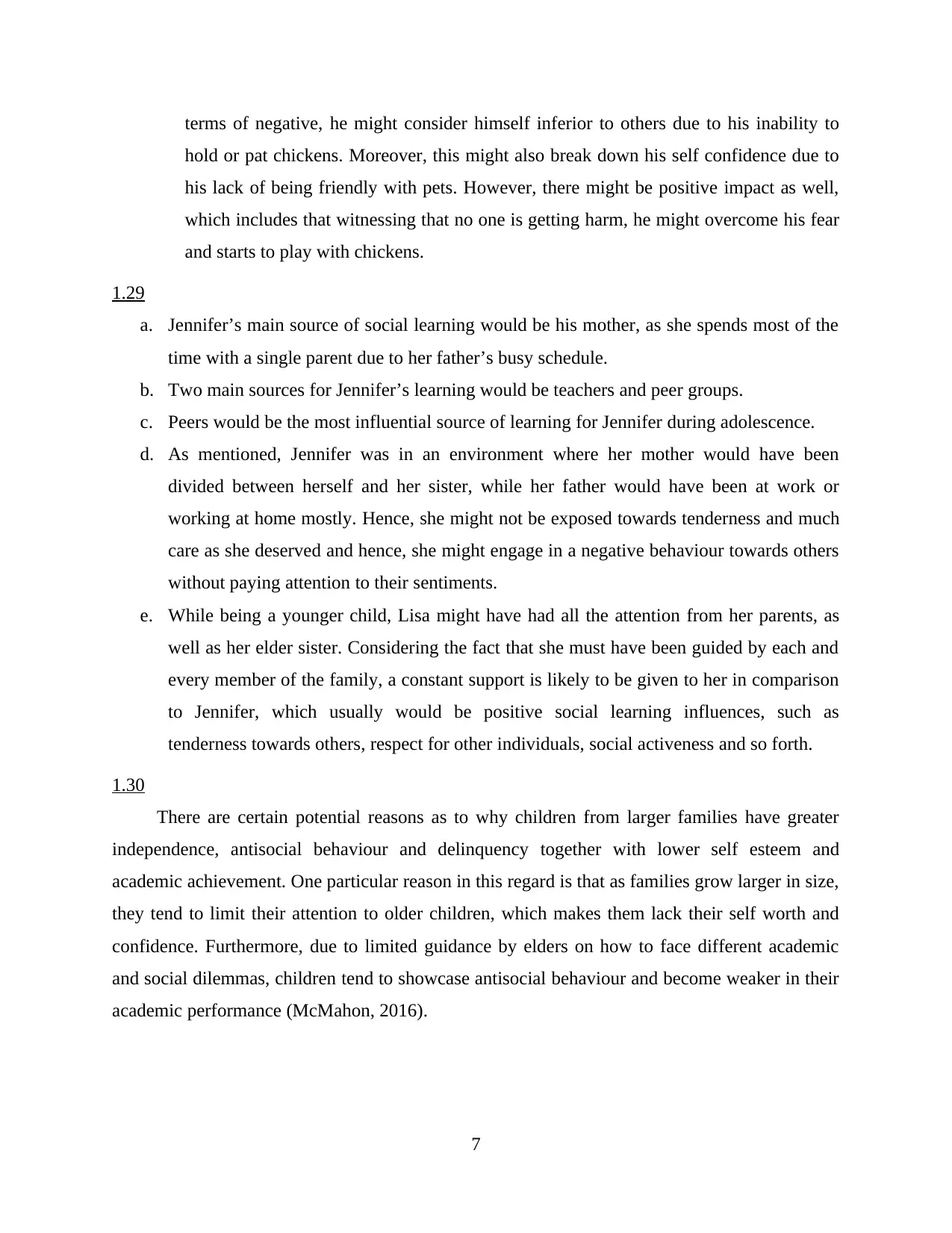
terms of negative, he might consider himself inferior to others due to his inability to
hold or pat chickens. Moreover, this might also break down his self confidence due to
his lack of being friendly with pets. However, there might be positive impact as well,
which includes that witnessing that no one is getting harm, he might overcome his fear
and starts to play with chickens.
1.29
a. Jennifer’s main source of social learning would be his mother, as she spends most of the
time with a single parent due to her father’s busy schedule.
b. Two main sources for Jennifer’s learning would be teachers and peer groups.
c. Peers would be the most influential source of learning for Jennifer during adolescence.
d. As mentioned, Jennifer was in an environment where her mother would have been
divided between herself and her sister, while her father would have been at work or
working at home mostly. Hence, she might not be exposed towards tenderness and much
care as she deserved and hence, she might engage in a negative behaviour towards others
without paying attention to their sentiments.
e. While being a younger child, Lisa might have had all the attention from her parents, as
well as her elder sister. Considering the fact that she must have been guided by each and
every member of the family, a constant support is likely to be given to her in comparison
to Jennifer, which usually would be positive social learning influences, such as
tenderness towards others, respect for other individuals, social activeness and so forth.
1.30
There are certain potential reasons as to why children from larger families have greater
independence, antisocial behaviour and delinquency together with lower self esteem and
academic achievement. One particular reason in this regard is that as families grow larger in size,
they tend to limit their attention to older children, which makes them lack their self worth and
confidence. Furthermore, due to limited guidance by elders on how to face different academic
and social dilemmas, children tend to showcase antisocial behaviour and become weaker in their
academic performance (McMahon, 2016).
7
hold or pat chickens. Moreover, this might also break down his self confidence due to
his lack of being friendly with pets. However, there might be positive impact as well,
which includes that witnessing that no one is getting harm, he might overcome his fear
and starts to play with chickens.
1.29
a. Jennifer’s main source of social learning would be his mother, as she spends most of the
time with a single parent due to her father’s busy schedule.
b. Two main sources for Jennifer’s learning would be teachers and peer groups.
c. Peers would be the most influential source of learning for Jennifer during adolescence.
d. As mentioned, Jennifer was in an environment where her mother would have been
divided between herself and her sister, while her father would have been at work or
working at home mostly. Hence, she might not be exposed towards tenderness and much
care as she deserved and hence, she might engage in a negative behaviour towards others
without paying attention to their sentiments.
e. While being a younger child, Lisa might have had all the attention from her parents, as
well as her elder sister. Considering the fact that she must have been guided by each and
every member of the family, a constant support is likely to be given to her in comparison
to Jennifer, which usually would be positive social learning influences, such as
tenderness towards others, respect for other individuals, social activeness and so forth.
1.30
There are certain potential reasons as to why children from larger families have greater
independence, antisocial behaviour and delinquency together with lower self esteem and
academic achievement. One particular reason in this regard is that as families grow larger in size,
they tend to limit their attention to older children, which makes them lack their self worth and
confidence. Furthermore, due to limited guidance by elders on how to face different academic
and social dilemmas, children tend to showcase antisocial behaviour and become weaker in their
academic performance (McMahon, 2016).
7
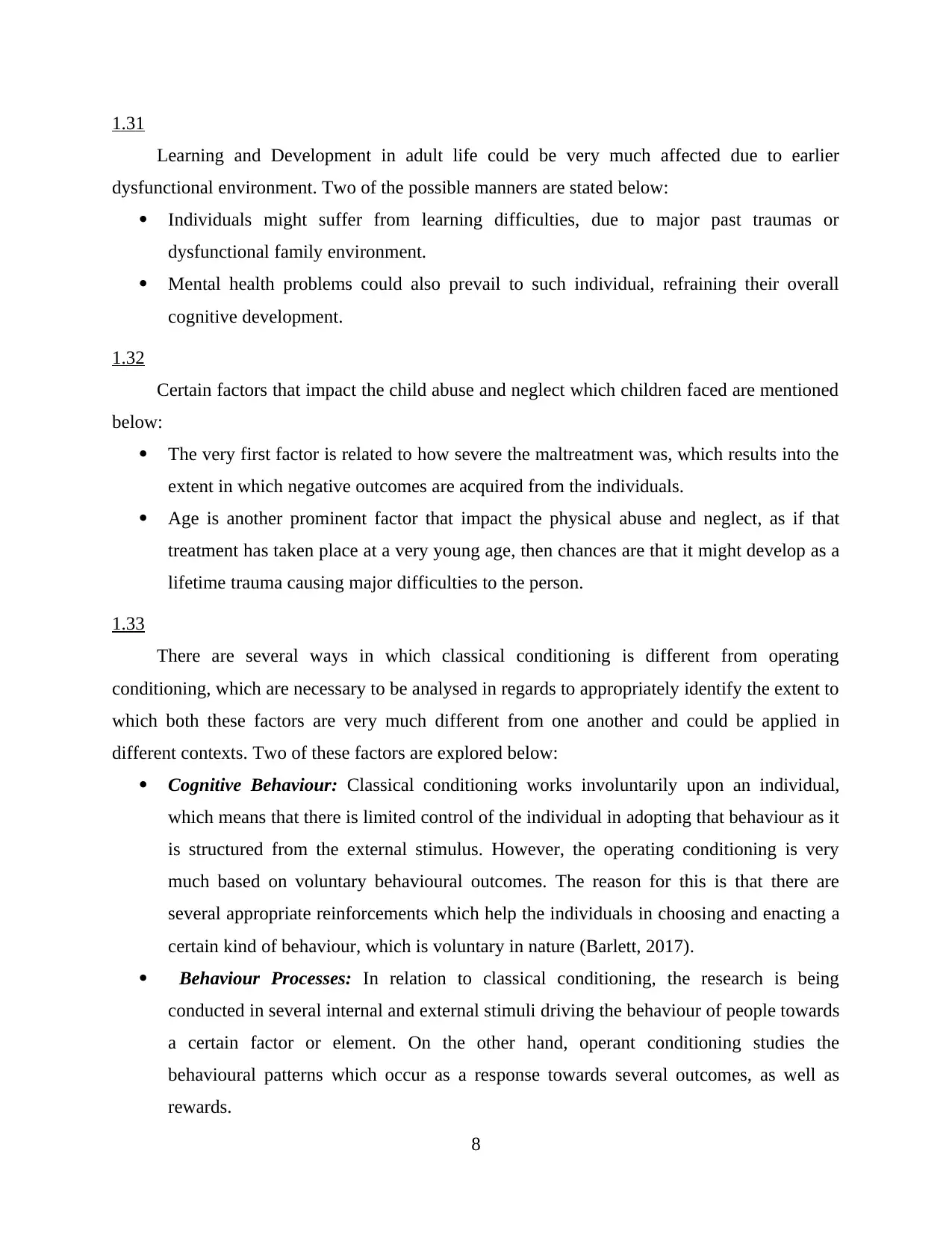
1.31
Learning and Development in adult life could be very much affected due to earlier
dysfunctional environment. Two of the possible manners are stated below:
Individuals might suffer from learning difficulties, due to major past traumas or
dysfunctional family environment.
Mental health problems could also prevail to such individual, refraining their overall
cognitive development.
1.32
Certain factors that impact the child abuse and neglect which children faced are mentioned
below:
The very first factor is related to how severe the maltreatment was, which results into the
extent in which negative outcomes are acquired from the individuals.
Age is another prominent factor that impact the physical abuse and neglect, as if that
treatment has taken place at a very young age, then chances are that it might develop as a
lifetime trauma causing major difficulties to the person.
1.33
There are several ways in which classical conditioning is different from operating
conditioning, which are necessary to be analysed in regards to appropriately identify the extent to
which both these factors are very much different from one another and could be applied in
different contexts. Two of these factors are explored below:
Cognitive Behaviour: Classical conditioning works involuntarily upon an individual,
which means that there is limited control of the individual in adopting that behaviour as it
is structured from the external stimulus. However, the operating conditioning is very
much based on voluntary behavioural outcomes. The reason for this is that there are
several appropriate reinforcements which help the individuals in choosing and enacting a
certain kind of behaviour, which is voluntary in nature (Barlett, 2017).
Behaviour Processes: In relation to classical conditioning, the research is being
conducted in several internal and external stimuli driving the behaviour of people towards
a certain factor or element. On the other hand, operant conditioning studies the
behavioural patterns which occur as a response towards several outcomes, as well as
rewards.
8
Learning and Development in adult life could be very much affected due to earlier
dysfunctional environment. Two of the possible manners are stated below:
Individuals might suffer from learning difficulties, due to major past traumas or
dysfunctional family environment.
Mental health problems could also prevail to such individual, refraining their overall
cognitive development.
1.32
Certain factors that impact the child abuse and neglect which children faced are mentioned
below:
The very first factor is related to how severe the maltreatment was, which results into the
extent in which negative outcomes are acquired from the individuals.
Age is another prominent factor that impact the physical abuse and neglect, as if that
treatment has taken place at a very young age, then chances are that it might develop as a
lifetime trauma causing major difficulties to the person.
1.33
There are several ways in which classical conditioning is different from operating
conditioning, which are necessary to be analysed in regards to appropriately identify the extent to
which both these factors are very much different from one another and could be applied in
different contexts. Two of these factors are explored below:
Cognitive Behaviour: Classical conditioning works involuntarily upon an individual,
which means that there is limited control of the individual in adopting that behaviour as it
is structured from the external stimulus. However, the operating conditioning is very
much based on voluntary behavioural outcomes. The reason for this is that there are
several appropriate reinforcements which help the individuals in choosing and enacting a
certain kind of behaviour, which is voluntary in nature (Barlett, 2017).
Behaviour Processes: In relation to classical conditioning, the research is being
conducted in several internal and external stimuli driving the behaviour of people towards
a certain factor or element. On the other hand, operant conditioning studies the
behavioural patterns which occur as a response towards several outcomes, as well as
rewards.
8
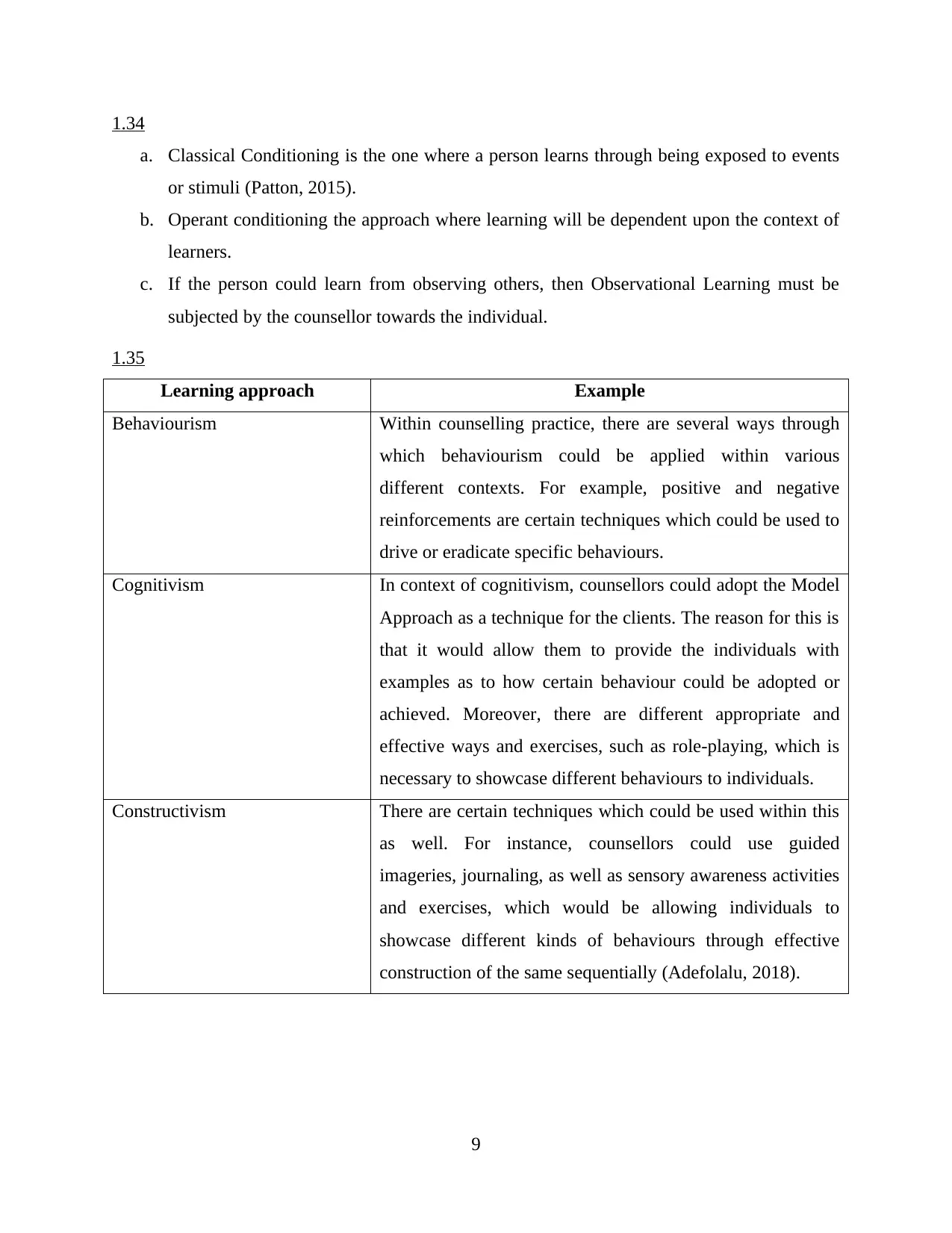
1.34
a. Classical Conditioning is the one where a person learns through being exposed to events
or stimuli (Patton, 2015).
b. Operant conditioning the approach where learning will be dependent upon the context of
learners.
c. If the person could learn from observing others, then Observational Learning must be
subjected by the counsellor towards the individual.
1.35
Learning approach Example
Behaviourism Within counselling practice, there are several ways through
which behaviourism could be applied within various
different contexts. For example, positive and negative
reinforcements are certain techniques which could be used to
drive or eradicate specific behaviours.
Cognitivism In context of cognitivism, counsellors could adopt the Model
Approach as a technique for the clients. The reason for this is
that it would allow them to provide the individuals with
examples as to how certain behaviour could be adopted or
achieved. Moreover, there are different appropriate and
effective ways and exercises, such as role-playing, which is
necessary to showcase different behaviours to individuals.
Constructivism There are certain techniques which could be used within this
as well. For instance, counsellors could use guided
imageries, journaling, as well as sensory awareness activities
and exercises, which would be allowing individuals to
showcase different kinds of behaviours through effective
construction of the same sequentially (Adefolalu, 2018).
9
a. Classical Conditioning is the one where a person learns through being exposed to events
or stimuli (Patton, 2015).
b. Operant conditioning the approach where learning will be dependent upon the context of
learners.
c. If the person could learn from observing others, then Observational Learning must be
subjected by the counsellor towards the individual.
1.35
Learning approach Example
Behaviourism Within counselling practice, there are several ways through
which behaviourism could be applied within various
different contexts. For example, positive and negative
reinforcements are certain techniques which could be used to
drive or eradicate specific behaviours.
Cognitivism In context of cognitivism, counsellors could adopt the Model
Approach as a technique for the clients. The reason for this is
that it would allow them to provide the individuals with
examples as to how certain behaviour could be adopted or
achieved. Moreover, there are different appropriate and
effective ways and exercises, such as role-playing, which is
necessary to showcase different behaviours to individuals.
Constructivism There are certain techniques which could be used within this
as well. For instance, counsellors could use guided
imageries, journaling, as well as sensory awareness activities
and exercises, which would be allowing individuals to
showcase different kinds of behaviours through effective
construction of the same sequentially (Adefolalu, 2018).
9
Secure Best Marks with AI Grader
Need help grading? Try our AI Grader for instant feedback on your assignments.
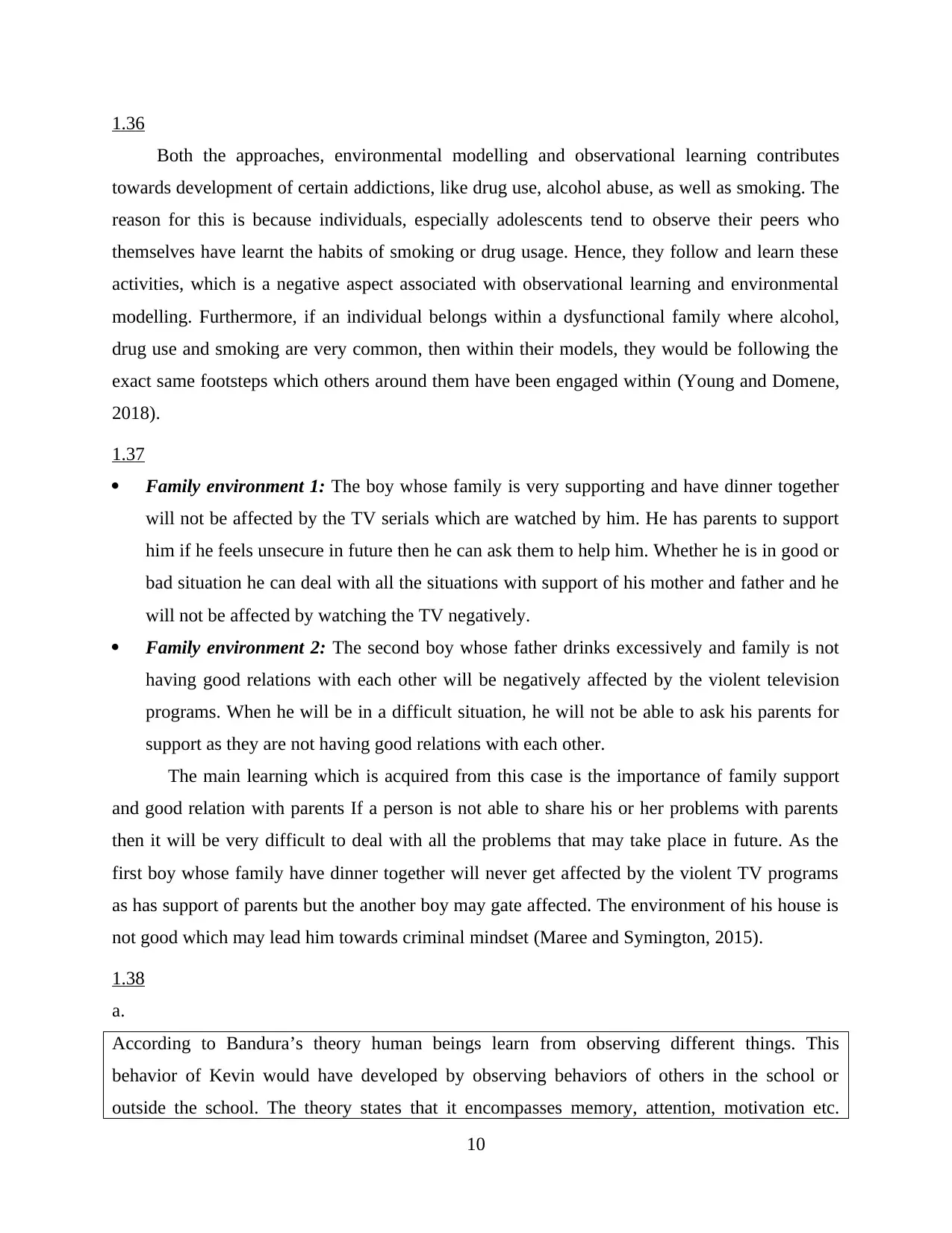
1.36
Both the approaches, environmental modelling and observational learning contributes
towards development of certain addictions, like drug use, alcohol abuse, as well as smoking. The
reason for this is because individuals, especially adolescents tend to observe their peers who
themselves have learnt the habits of smoking or drug usage. Hence, they follow and learn these
activities, which is a negative aspect associated with observational learning and environmental
modelling. Furthermore, if an individual belongs within a dysfunctional family where alcohol,
drug use and smoking are very common, then within their models, they would be following the
exact same footsteps which others around them have been engaged within (Young and Domene,
2018).
1.37
Family environment 1: The boy whose family is very supporting and have dinner together
will not be affected by the TV serials which are watched by him. He has parents to support
him if he feels unsecure in future then he can ask them to help him. Whether he is in good or
bad situation he can deal with all the situations with support of his mother and father and he
will not be affected by watching the TV negatively.
Family environment 2: The second boy whose father drinks excessively and family is not
having good relations with each other will be negatively affected by the violent television
programs. When he will be in a difficult situation, he will not be able to ask his parents for
support as they are not having good relations with each other.
The main learning which is acquired from this case is the importance of family support
and good relation with parents If a person is not able to share his or her problems with parents
then it will be very difficult to deal with all the problems that may take place in future. As the
first boy whose family have dinner together will never get affected by the violent TV programs
as has support of parents but the another boy may gate affected. The environment of his house is
not good which may lead him towards criminal mindset (Maree and Symington, 2015).
1.38
a.
According to Bandura’s theory human beings learn from observing different things. This
behavior of Kevin would have developed by observing behaviors of others in the school or
outside the school. The theory states that it encompasses memory, attention, motivation etc.
10
Both the approaches, environmental modelling and observational learning contributes
towards development of certain addictions, like drug use, alcohol abuse, as well as smoking. The
reason for this is because individuals, especially adolescents tend to observe their peers who
themselves have learnt the habits of smoking or drug usage. Hence, they follow and learn these
activities, which is a negative aspect associated with observational learning and environmental
modelling. Furthermore, if an individual belongs within a dysfunctional family where alcohol,
drug use and smoking are very common, then within their models, they would be following the
exact same footsteps which others around them have been engaged within (Young and Domene,
2018).
1.37
Family environment 1: The boy whose family is very supporting and have dinner together
will not be affected by the TV serials which are watched by him. He has parents to support
him if he feels unsecure in future then he can ask them to help him. Whether he is in good or
bad situation he can deal with all the situations with support of his mother and father and he
will not be affected by watching the TV negatively.
Family environment 2: The second boy whose father drinks excessively and family is not
having good relations with each other will be negatively affected by the violent television
programs. When he will be in a difficult situation, he will not be able to ask his parents for
support as they are not having good relations with each other.
The main learning which is acquired from this case is the importance of family support
and good relation with parents If a person is not able to share his or her problems with parents
then it will be very difficult to deal with all the problems that may take place in future. As the
first boy whose family have dinner together will never get affected by the violent TV programs
as has support of parents but the another boy may gate affected. The environment of his house is
not good which may lead him towards criminal mindset (Maree and Symington, 2015).
1.38
a.
According to Bandura’s theory human beings learn from observing different things. This
behavior of Kevin would have developed by observing behaviors of others in the school or
outside the school. The theory states that it encompasses memory, attention, motivation etc.
10
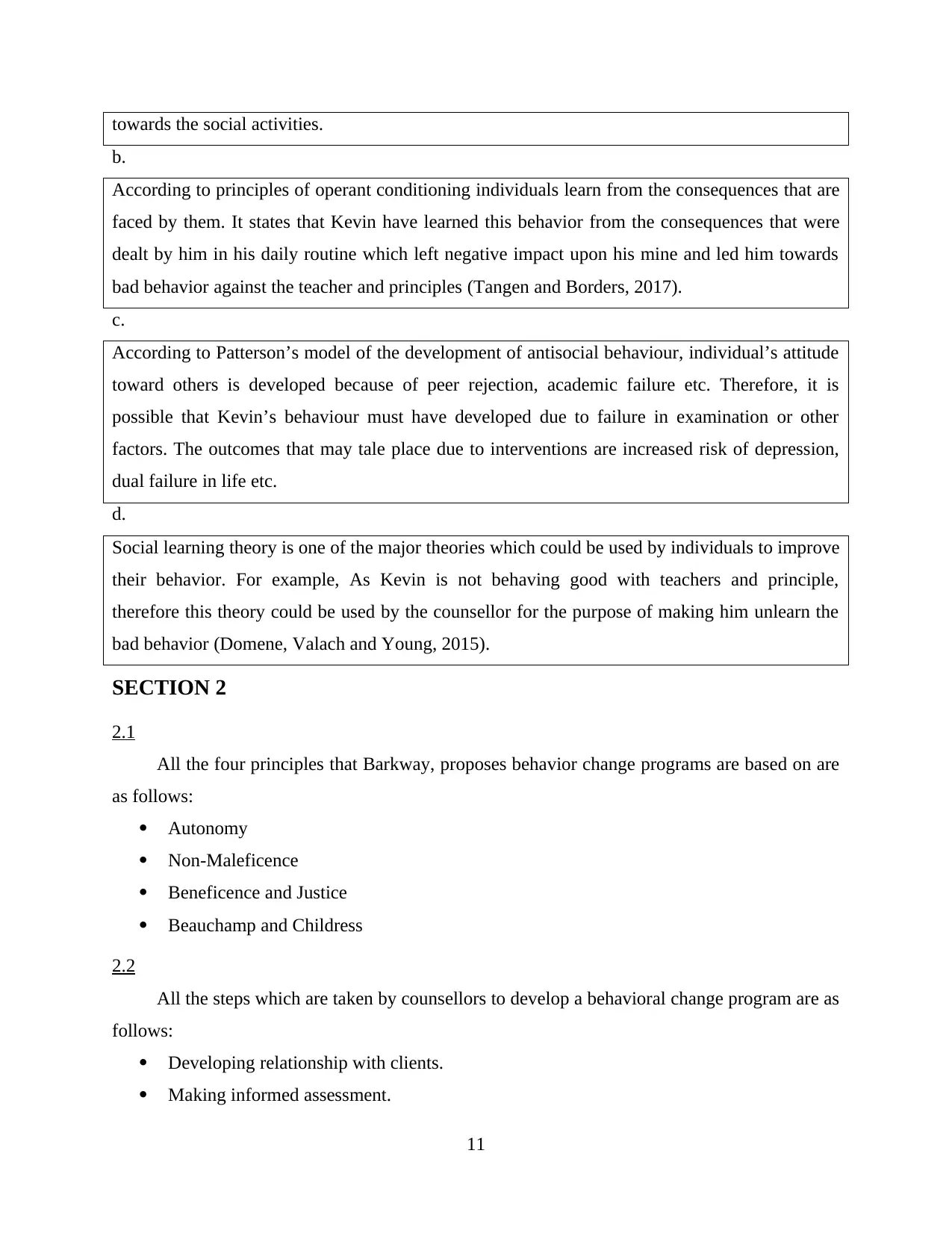
towards the social activities.
b.
According to principles of operant conditioning individuals learn from the consequences that are
faced by them. It states that Kevin have learned this behavior from the consequences that were
dealt by him in his daily routine which left negative impact upon his mine and led him towards
bad behavior against the teacher and principles (Tangen and Borders, 2017).
c.
According to Patterson’s model of the development of antisocial behaviour, individual’s attitude
toward others is developed because of peer rejection, academic failure etc. Therefore, it is
possible that Kevin’s behaviour must have developed due to failure in examination or other
factors. The outcomes that may tale place due to interventions are increased risk of depression,
dual failure in life etc.
d.
Social learning theory is one of the major theories which could be used by individuals to improve
their behavior. For example, As Kevin is not behaving good with teachers and principle,
therefore this theory could be used by the counsellor for the purpose of making him unlearn the
bad behavior (Domene, Valach and Young, 2015).
SECTION 2
2.1
All the four principles that Barkway, proposes behavior change programs are based on are
as follows:
Autonomy
Non-Maleficence
Beneficence and Justice
Beauchamp and Childress
2.2
All the steps which are taken by counsellors to develop a behavioral change program are as
follows:
Developing relationship with clients.
Making informed assessment.
11
b.
According to principles of operant conditioning individuals learn from the consequences that are
faced by them. It states that Kevin have learned this behavior from the consequences that were
dealt by him in his daily routine which left negative impact upon his mine and led him towards
bad behavior against the teacher and principles (Tangen and Borders, 2017).
c.
According to Patterson’s model of the development of antisocial behaviour, individual’s attitude
toward others is developed because of peer rejection, academic failure etc. Therefore, it is
possible that Kevin’s behaviour must have developed due to failure in examination or other
factors. The outcomes that may tale place due to interventions are increased risk of depression,
dual failure in life etc.
d.
Social learning theory is one of the major theories which could be used by individuals to improve
their behavior. For example, As Kevin is not behaving good with teachers and principle,
therefore this theory could be used by the counsellor for the purpose of making him unlearn the
bad behavior (Domene, Valach and Young, 2015).
SECTION 2
2.1
All the four principles that Barkway, proposes behavior change programs are based on are
as follows:
Autonomy
Non-Maleficence
Beneficence and Justice
Beauchamp and Childress
2.2
All the steps which are taken by counsellors to develop a behavioral change program are as
follows:
Developing relationship with clients.
Making informed assessment.
11
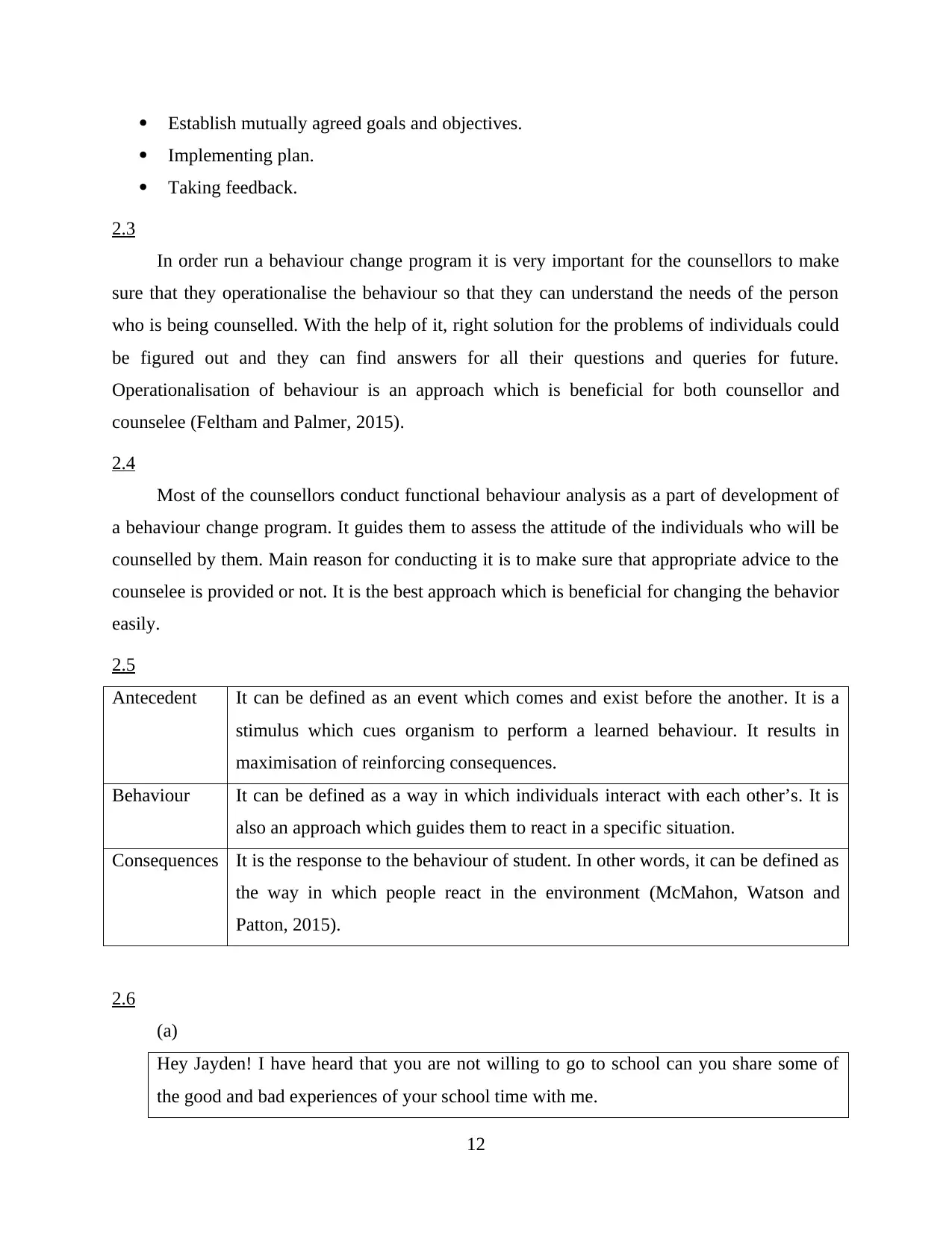
Establish mutually agreed goals and objectives.
Implementing plan.
Taking feedback.
2.3
In order run a behaviour change program it is very important for the counsellors to make
sure that they operationalise the behaviour so that they can understand the needs of the person
who is being counselled. With the help of it, right solution for the problems of individuals could
be figured out and they can find answers for all their questions and queries for future.
Operationalisation of behaviour is an approach which is beneficial for both counsellor and
counselee (Feltham and Palmer, 2015).
2.4
Most of the counsellors conduct functional behaviour analysis as a part of development of
a behaviour change program. It guides them to assess the attitude of the individuals who will be
counselled by them. Main reason for conducting it is to make sure that appropriate advice to the
counselee is provided or not. It is the best approach which is beneficial for changing the behavior
easily.
2.5
Antecedent It can be defined as an event which comes and exist before the another. It is a
stimulus which cues organism to perform a learned behaviour. It results in
maximisation of reinforcing consequences.
Behaviour It can be defined as a way in which individuals interact with each other’s. It is
also an approach which guides them to react in a specific situation.
Consequences It is the response to the behaviour of student. In other words, it can be defined as
the way in which people react in the environment (McMahon, Watson and
Patton, 2015).
2.6
(a)
Hey Jayden! I have heard that you are not willing to go to school can you share some of
the good and bad experiences of your school time with me.
12
Implementing plan.
Taking feedback.
2.3
In order run a behaviour change program it is very important for the counsellors to make
sure that they operationalise the behaviour so that they can understand the needs of the person
who is being counselled. With the help of it, right solution for the problems of individuals could
be figured out and they can find answers for all their questions and queries for future.
Operationalisation of behaviour is an approach which is beneficial for both counsellor and
counselee (Feltham and Palmer, 2015).
2.4
Most of the counsellors conduct functional behaviour analysis as a part of development of
a behaviour change program. It guides them to assess the attitude of the individuals who will be
counselled by them. Main reason for conducting it is to make sure that appropriate advice to the
counselee is provided or not. It is the best approach which is beneficial for changing the behavior
easily.
2.5
Antecedent It can be defined as an event which comes and exist before the another. It is a
stimulus which cues organism to perform a learned behaviour. It results in
maximisation of reinforcing consequences.
Behaviour It can be defined as a way in which individuals interact with each other’s. It is
also an approach which guides them to react in a specific situation.
Consequences It is the response to the behaviour of student. In other words, it can be defined as
the way in which people react in the environment (McMahon, Watson and
Patton, 2015).
2.6
(a)
Hey Jayden! I have heard that you are not willing to go to school can you share some of
the good and bad experiences of your school time with me.
12
Paraphrase This Document
Need a fresh take? Get an instant paraphrase of this document with our AI Paraphraser
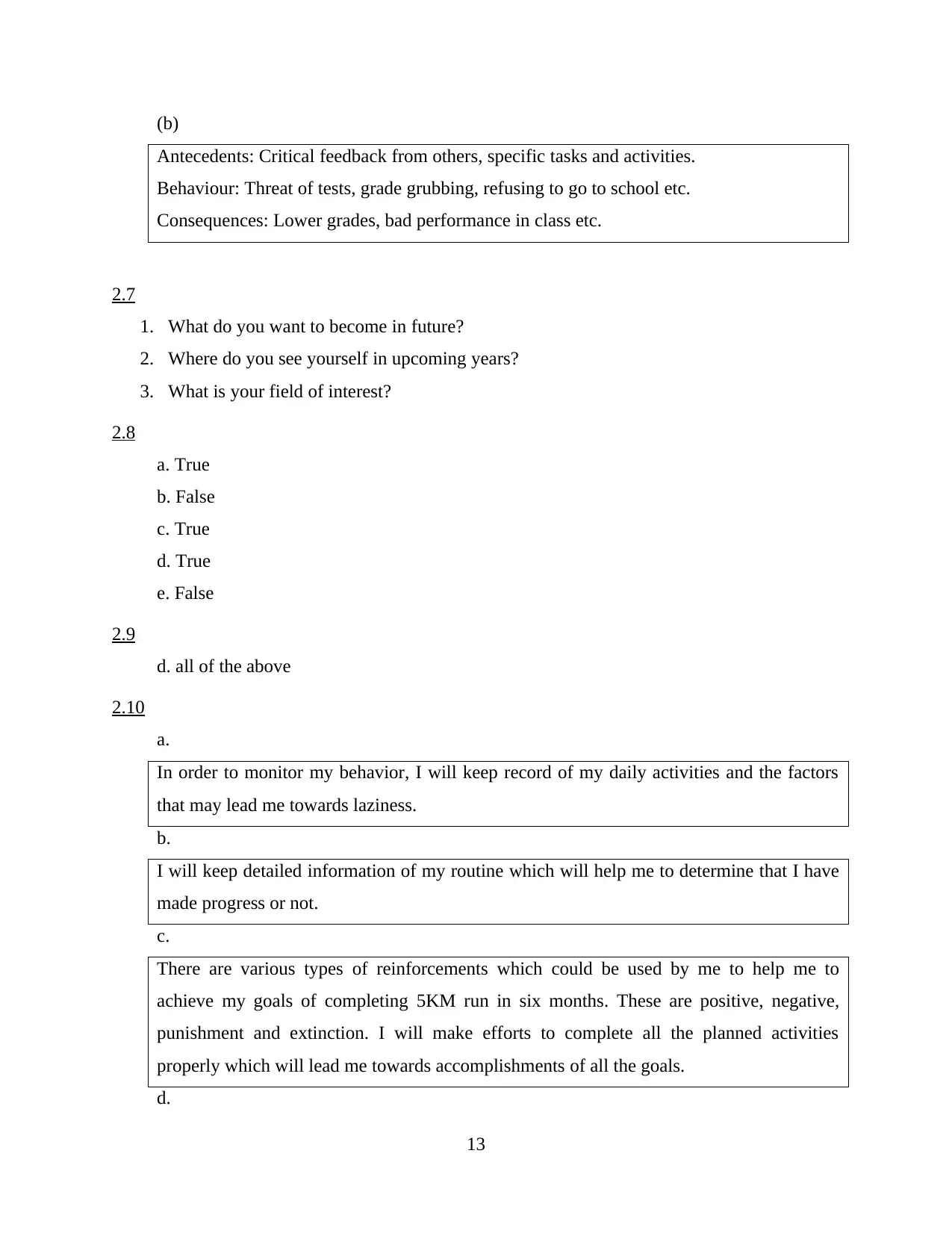
(b)
Antecedents: Critical feedback from others, specific tasks and activities.
Behaviour: Threat of tests, grade grubbing, refusing to go to school etc.
Consequences: Lower grades, bad performance in class etc.
2.7
1. What do you want to become in future?
2. Where do you see yourself in upcoming years?
3. What is your field of interest?
2.8
a. True
b. False
c. True
d. True
e. False
2.9
d. all of the above
2.10
a.
In order to monitor my behavior, I will keep record of my daily activities and the factors
that may lead me towards laziness.
b.
I will keep detailed information of my routine which will help me to determine that I have
made progress or not.
c.
There are various types of reinforcements which could be used by me to help me to
achieve my goals of completing 5KM run in six months. These are positive, negative,
punishment and extinction. I will make efforts to complete all the planned activities
properly which will lead me towards accomplishments of all the goals.
d.
13
Antecedents: Critical feedback from others, specific tasks and activities.
Behaviour: Threat of tests, grade grubbing, refusing to go to school etc.
Consequences: Lower grades, bad performance in class etc.
2.7
1. What do you want to become in future?
2. Where do you see yourself in upcoming years?
3. What is your field of interest?
2.8
a. True
b. False
c. True
d. True
e. False
2.9
d. all of the above
2.10
a.
In order to monitor my behavior, I will keep record of my daily activities and the factors
that may lead me towards laziness.
b.
I will keep detailed information of my routine which will help me to determine that I have
made progress or not.
c.
There are various types of reinforcements which could be used by me to help me to
achieve my goals of completing 5KM run in six months. These are positive, negative,
punishment and extinction. I will make efforts to complete all the planned activities
properly which will lead me towards accomplishments of all the goals.
d.
13
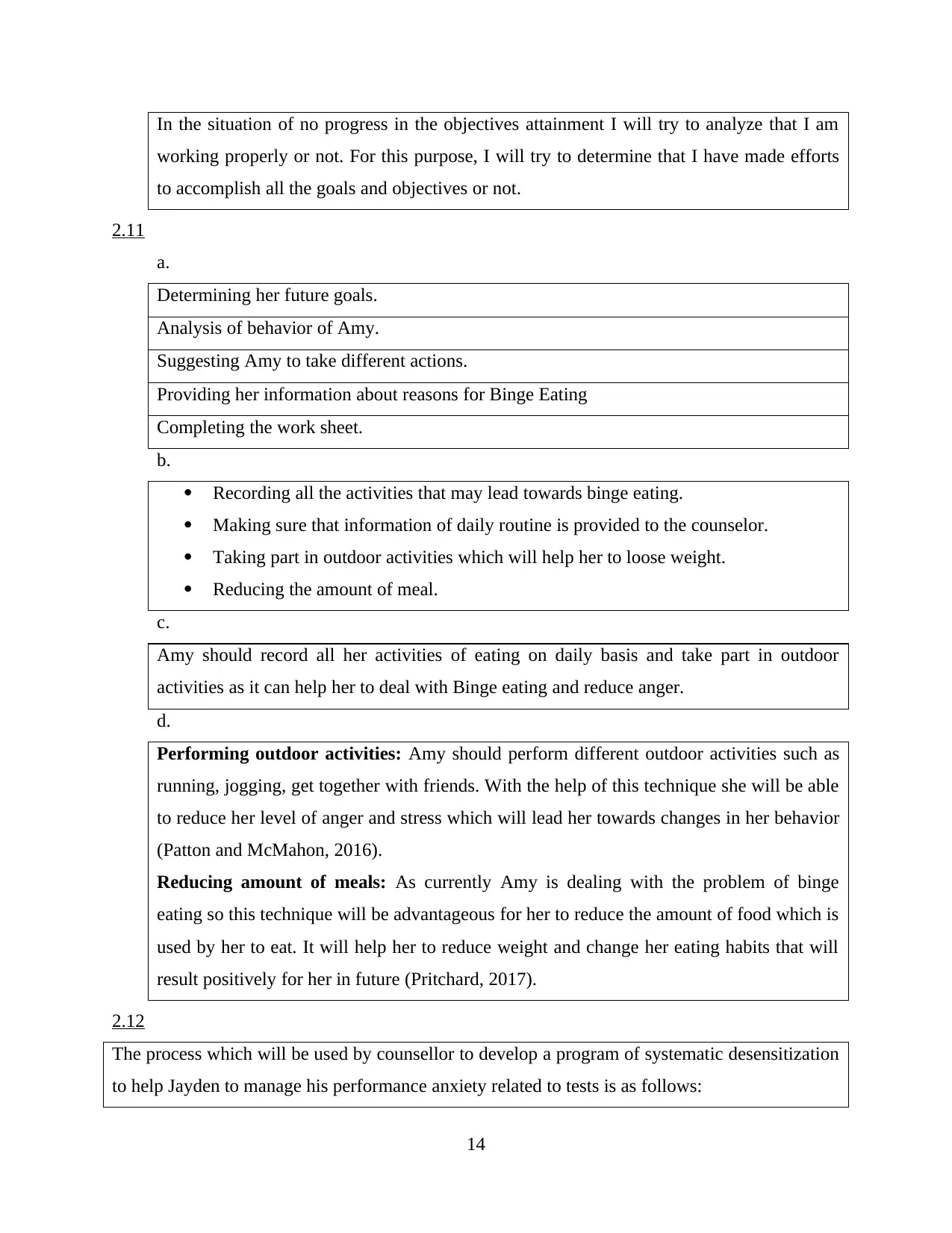
In the situation of no progress in the objectives attainment I will try to analyze that I am
working properly or not. For this purpose, I will try to determine that I have made efforts
to accomplish all the goals and objectives or not.
2.11
a.
Determining her future goals.
Analysis of behavior of Amy.
Suggesting Amy to take different actions.
Providing her information about reasons for Binge Eating
Completing the work sheet.
b.
Recording all the activities that may lead towards binge eating.
Making sure that information of daily routine is provided to the counselor.
Taking part in outdoor activities which will help her to loose weight.
Reducing the amount of meal.
c.
Amy should record all her activities of eating on daily basis and take part in outdoor
activities as it can help her to deal with Binge eating and reduce anger.
d.
Performing outdoor activities: Amy should perform different outdoor activities such as
running, jogging, get together with friends. With the help of this technique she will be able
to reduce her level of anger and stress which will lead her towards changes in her behavior
(Patton and McMahon, 2016).
Reducing amount of meals: As currently Amy is dealing with the problem of binge
eating so this technique will be advantageous for her to reduce the amount of food which is
used by her to eat. It will help her to reduce weight and change her eating habits that will
result positively for her in future (Pritchard, 2017).
2.12
The process which will be used by counsellor to develop a program of systematic desensitization
to help Jayden to manage his performance anxiety related to tests is as follows:
14
working properly or not. For this purpose, I will try to determine that I have made efforts
to accomplish all the goals and objectives or not.
2.11
a.
Determining her future goals.
Analysis of behavior of Amy.
Suggesting Amy to take different actions.
Providing her information about reasons for Binge Eating
Completing the work sheet.
b.
Recording all the activities that may lead towards binge eating.
Making sure that information of daily routine is provided to the counselor.
Taking part in outdoor activities which will help her to loose weight.
Reducing the amount of meal.
c.
Amy should record all her activities of eating on daily basis and take part in outdoor
activities as it can help her to deal with Binge eating and reduce anger.
d.
Performing outdoor activities: Amy should perform different outdoor activities such as
running, jogging, get together with friends. With the help of this technique she will be able
to reduce her level of anger and stress which will lead her towards changes in her behavior
(Patton and McMahon, 2016).
Reducing amount of meals: As currently Amy is dealing with the problem of binge
eating so this technique will be advantageous for her to reduce the amount of food which is
used by her to eat. It will help her to reduce weight and change her eating habits that will
result positively for her in future (Pritchard, 2017).
2.12
The process which will be used by counsellor to develop a program of systematic desensitization
to help Jayden to manage his performance anxiety related to tests is as follows:
14
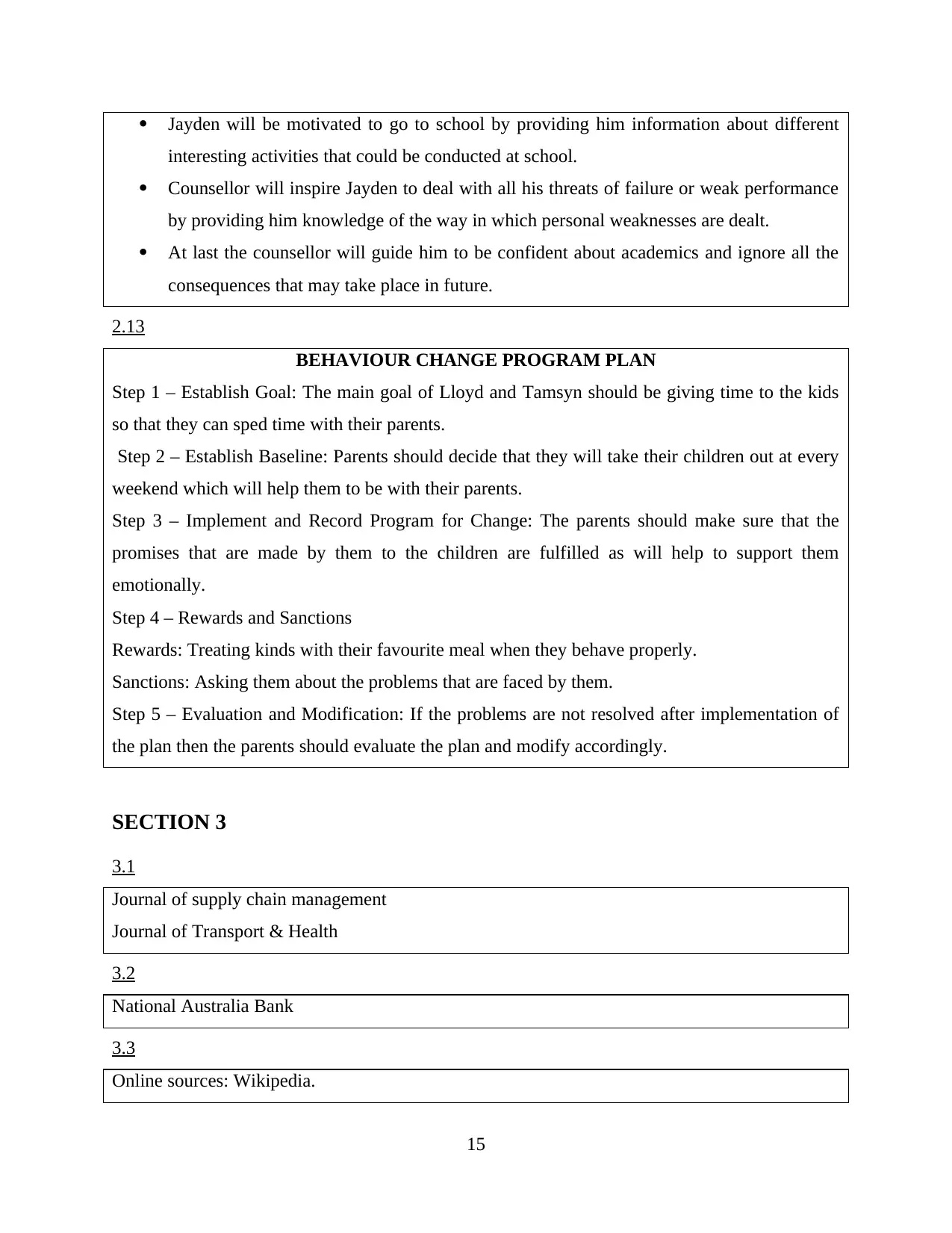
Jayden will be motivated to go to school by providing him information about different
interesting activities that could be conducted at school.
Counsellor will inspire Jayden to deal with all his threats of failure or weak performance
by providing him knowledge of the way in which personal weaknesses are dealt.
At last the counsellor will guide him to be confident about academics and ignore all the
consequences that may take place in future.
2.13
BEHAVIOUR CHANGE PROGRAM PLAN
Step 1 – Establish Goal: The main goal of Lloyd and Tamsyn should be giving time to the kids
so that they can sped time with their parents.
Step 2 – Establish Baseline: Parents should decide that they will take their children out at every
weekend which will help them to be with their parents.
Step 3 – Implement and Record Program for Change: The parents should make sure that the
promises that are made by them to the children are fulfilled as will help to support them
emotionally.
Step 4 – Rewards and Sanctions
Rewards: Treating kinds with their favourite meal when they behave properly.
Sanctions: Asking them about the problems that are faced by them.
Step 5 – Evaluation and Modification: If the problems are not resolved after implementation of
the plan then the parents should evaluate the plan and modify accordingly.
SECTION 3
3.1
Journal of supply chain management
Journal of Transport & Health
3.2
National Australia Bank
3.3
Online sources: Wikipedia.
15
interesting activities that could be conducted at school.
Counsellor will inspire Jayden to deal with all his threats of failure or weak performance
by providing him knowledge of the way in which personal weaknesses are dealt.
At last the counsellor will guide him to be confident about academics and ignore all the
consequences that may take place in future.
2.13
BEHAVIOUR CHANGE PROGRAM PLAN
Step 1 – Establish Goal: The main goal of Lloyd and Tamsyn should be giving time to the kids
so that they can sped time with their parents.
Step 2 – Establish Baseline: Parents should decide that they will take their children out at every
weekend which will help them to be with their parents.
Step 3 – Implement and Record Program for Change: The parents should make sure that the
promises that are made by them to the children are fulfilled as will help to support them
emotionally.
Step 4 – Rewards and Sanctions
Rewards: Treating kinds with their favourite meal when they behave properly.
Sanctions: Asking them about the problems that are faced by them.
Step 5 – Evaluation and Modification: If the problems are not resolved after implementation of
the plan then the parents should evaluate the plan and modify accordingly.
SECTION 3
3.1
Journal of supply chain management
Journal of Transport & Health
3.2
National Australia Bank
3.3
Online sources: Wikipedia.
15
Secure Best Marks with AI Grader
Need help grading? Try our AI Grader for instant feedback on your assignments.
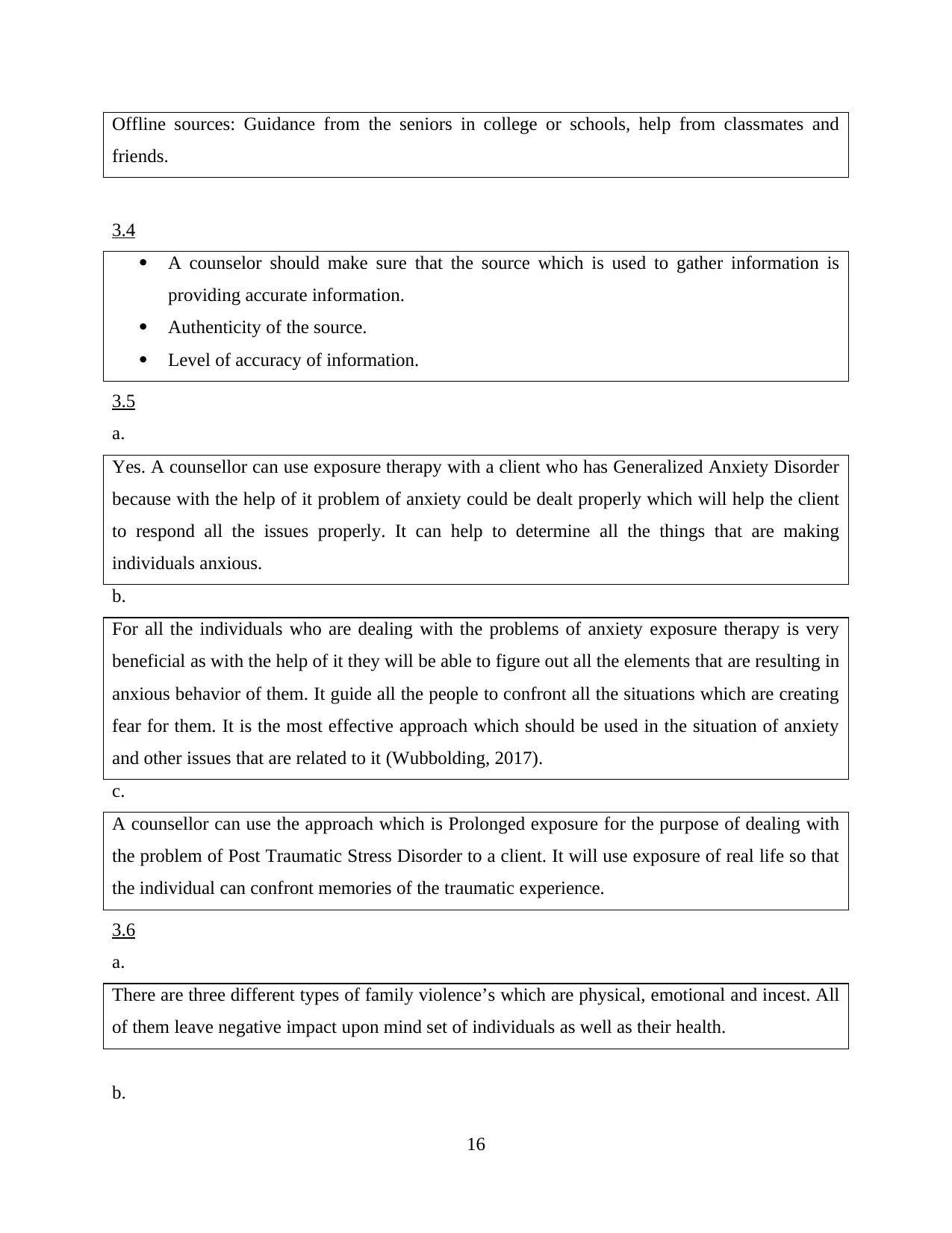
Offline sources: Guidance from the seniors in college or schools, help from classmates and
friends.
3.4
A counselor should make sure that the source which is used to gather information is
providing accurate information.
Authenticity of the source.
Level of accuracy of information.
3.5
a.
Yes. A counsellor can use exposure therapy with a client who has Generalized Anxiety Disorder
because with the help of it problem of anxiety could be dealt properly which will help the client
to respond all the issues properly. It can help to determine all the things that are making
individuals anxious.
b.
For all the individuals who are dealing with the problems of anxiety exposure therapy is very
beneficial as with the help of it they will be able to figure out all the elements that are resulting in
anxious behavior of them. It guide all the people to confront all the situations which are creating
fear for them. It is the most effective approach which should be used in the situation of anxiety
and other issues that are related to it (Wubbolding, 2017).
c.
A counsellor can use the approach which is Prolonged exposure for the purpose of dealing with
the problem of Post Traumatic Stress Disorder to a client. It will use exposure of real life so that
the individual can confront memories of the traumatic experience.
3.6
a.
There are three different types of family violence’s which are physical, emotional and incest. All
of them leave negative impact upon mind set of individuals as well as their health.
b.
16
friends.
3.4
A counselor should make sure that the source which is used to gather information is
providing accurate information.
Authenticity of the source.
Level of accuracy of information.
3.5
a.
Yes. A counsellor can use exposure therapy with a client who has Generalized Anxiety Disorder
because with the help of it problem of anxiety could be dealt properly which will help the client
to respond all the issues properly. It can help to determine all the things that are making
individuals anxious.
b.
For all the individuals who are dealing with the problems of anxiety exposure therapy is very
beneficial as with the help of it they will be able to figure out all the elements that are resulting in
anxious behavior of them. It guide all the people to confront all the situations which are creating
fear for them. It is the most effective approach which should be used in the situation of anxiety
and other issues that are related to it (Wubbolding, 2017).
c.
A counsellor can use the approach which is Prolonged exposure for the purpose of dealing with
the problem of Post Traumatic Stress Disorder to a client. It will use exposure of real life so that
the individual can confront memories of the traumatic experience.
3.6
a.
There are three different types of family violence’s which are physical, emotional and incest. All
of them leave negative impact upon mind set of individuals as well as their health.
b.
16
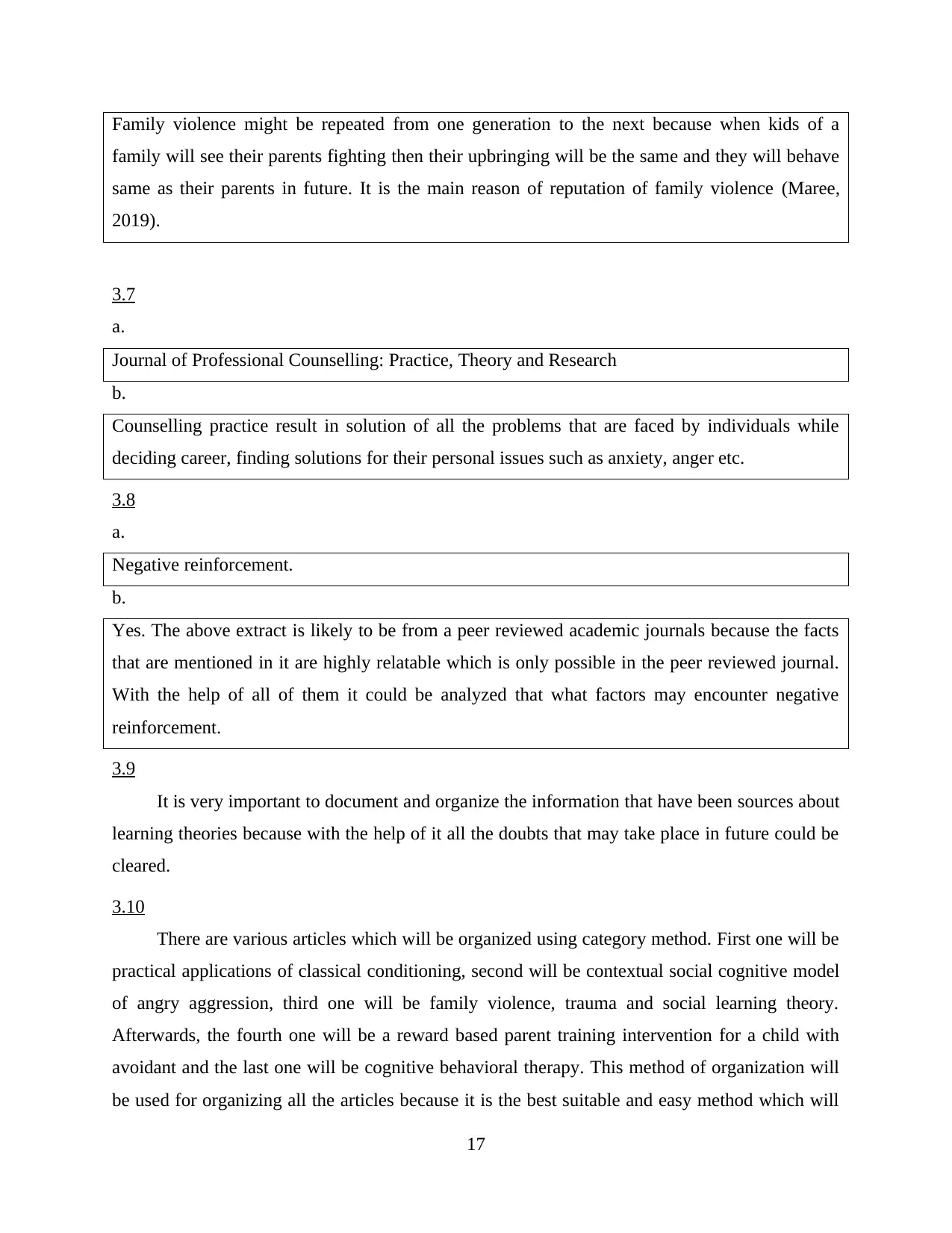
Family violence might be repeated from one generation to the next because when kids of a
family will see their parents fighting then their upbringing will be the same and they will behave
same as their parents in future. It is the main reason of reputation of family violence (Maree,
2019).
3.7
a.
Journal of Professional Counselling: Practice, Theory and Research
b.
Counselling practice result in solution of all the problems that are faced by individuals while
deciding career, finding solutions for their personal issues such as anxiety, anger etc.
3.8
a.
Negative reinforcement.
b.
Yes. The above extract is likely to be from a peer reviewed academic journals because the facts
that are mentioned in it are highly relatable which is only possible in the peer reviewed journal.
With the help of all of them it could be analyzed that what factors may encounter negative
reinforcement.
3.9
It is very important to document and organize the information that have been sources about
learning theories because with the help of it all the doubts that may take place in future could be
cleared.
3.10
There are various articles which will be organized using category method. First one will be
practical applications of classical conditioning, second will be contextual social cognitive model
of angry aggression, third one will be family violence, trauma and social learning theory.
Afterwards, the fourth one will be a reward based parent training intervention for a child with
avoidant and the last one will be cognitive behavioral therapy. This method of organization will
be used for organizing all the articles because it is the best suitable and easy method which will
17
family will see their parents fighting then their upbringing will be the same and they will behave
same as their parents in future. It is the main reason of reputation of family violence (Maree,
2019).
3.7
a.
Journal of Professional Counselling: Practice, Theory and Research
b.
Counselling practice result in solution of all the problems that are faced by individuals while
deciding career, finding solutions for their personal issues such as anxiety, anger etc.
3.8
a.
Negative reinforcement.
b.
Yes. The above extract is likely to be from a peer reviewed academic journals because the facts
that are mentioned in it are highly relatable which is only possible in the peer reviewed journal.
With the help of all of them it could be analyzed that what factors may encounter negative
reinforcement.
3.9
It is very important to document and organize the information that have been sources about
learning theories because with the help of it all the doubts that may take place in future could be
cleared.
3.10
There are various articles which will be organized using category method. First one will be
practical applications of classical conditioning, second will be contextual social cognitive model
of angry aggression, third one will be family violence, trauma and social learning theory.
Afterwards, the fourth one will be a reward based parent training intervention for a child with
avoidant and the last one will be cognitive behavioral therapy. This method of organization will
be used for organizing all the articles because it is the best suitable and easy method which will
17
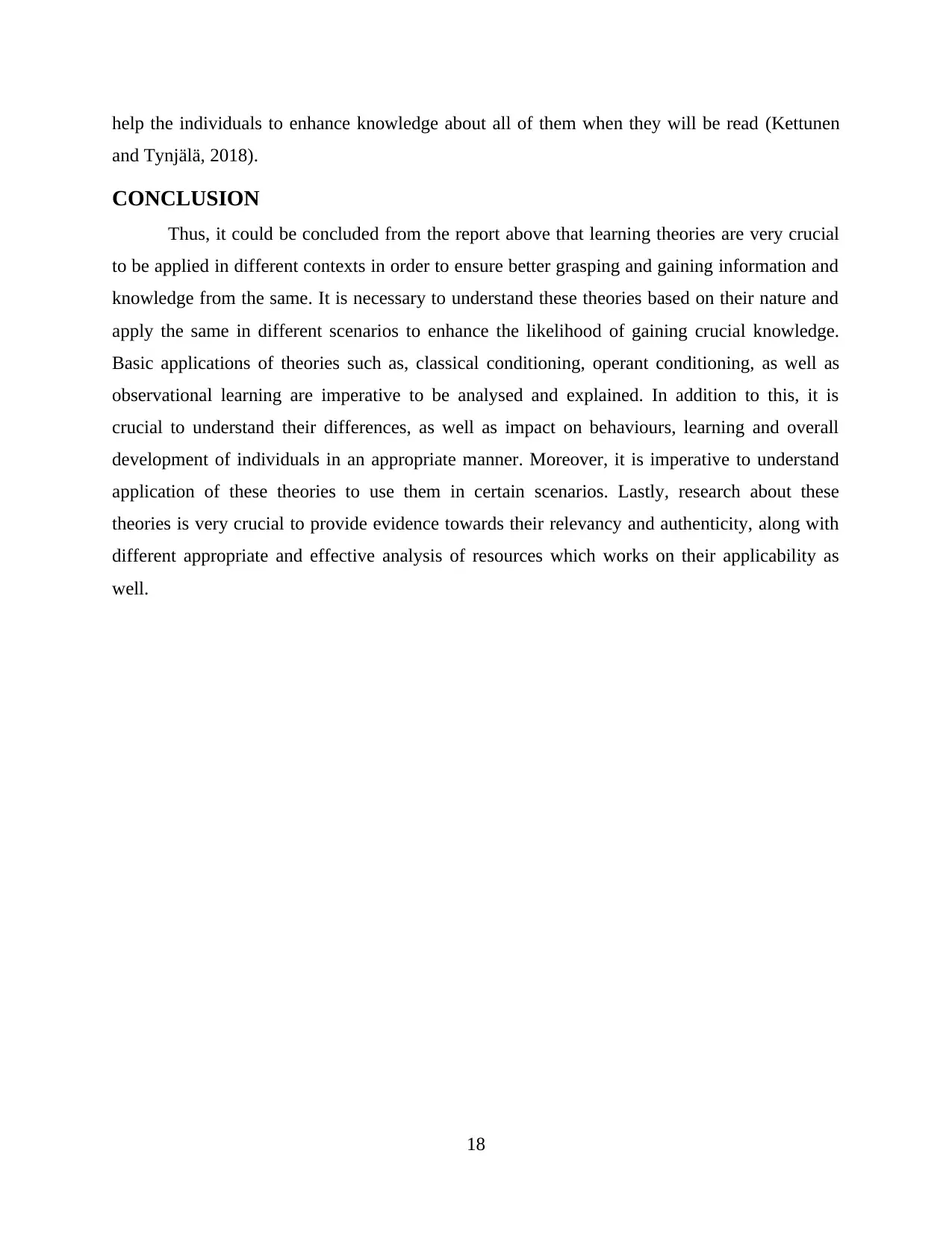
help the individuals to enhance knowledge about all of them when they will be read (Kettunen
and Tynjälä, 2018).
CONCLUSION
Thus, it could be concluded from the report above that learning theories are very crucial
to be applied in different contexts in order to ensure better grasping and gaining information and
knowledge from the same. It is necessary to understand these theories based on their nature and
apply the same in different scenarios to enhance the likelihood of gaining crucial knowledge.
Basic applications of theories such as, classical conditioning, operant conditioning, as well as
observational learning are imperative to be analysed and explained. In addition to this, it is
crucial to understand their differences, as well as impact on behaviours, learning and overall
development of individuals in an appropriate manner. Moreover, it is imperative to understand
application of these theories to use them in certain scenarios. Lastly, research about these
theories is very crucial to provide evidence towards their relevancy and authenticity, along with
different appropriate and effective analysis of resources which works on their applicability as
well.
18
and Tynjälä, 2018).
CONCLUSION
Thus, it could be concluded from the report above that learning theories are very crucial
to be applied in different contexts in order to ensure better grasping and gaining information and
knowledge from the same. It is necessary to understand these theories based on their nature and
apply the same in different scenarios to enhance the likelihood of gaining crucial knowledge.
Basic applications of theories such as, classical conditioning, operant conditioning, as well as
observational learning are imperative to be analysed and explained. In addition to this, it is
crucial to understand their differences, as well as impact on behaviours, learning and overall
development of individuals in an appropriate manner. Moreover, it is imperative to understand
application of these theories to use them in certain scenarios. Lastly, research about these
theories is very crucial to provide evidence towards their relevancy and authenticity, along with
different appropriate and effective analysis of resources which works on their applicability as
well.
18
Paraphrase This Document
Need a fresh take? Get an instant paraphrase of this document with our AI Paraphraser
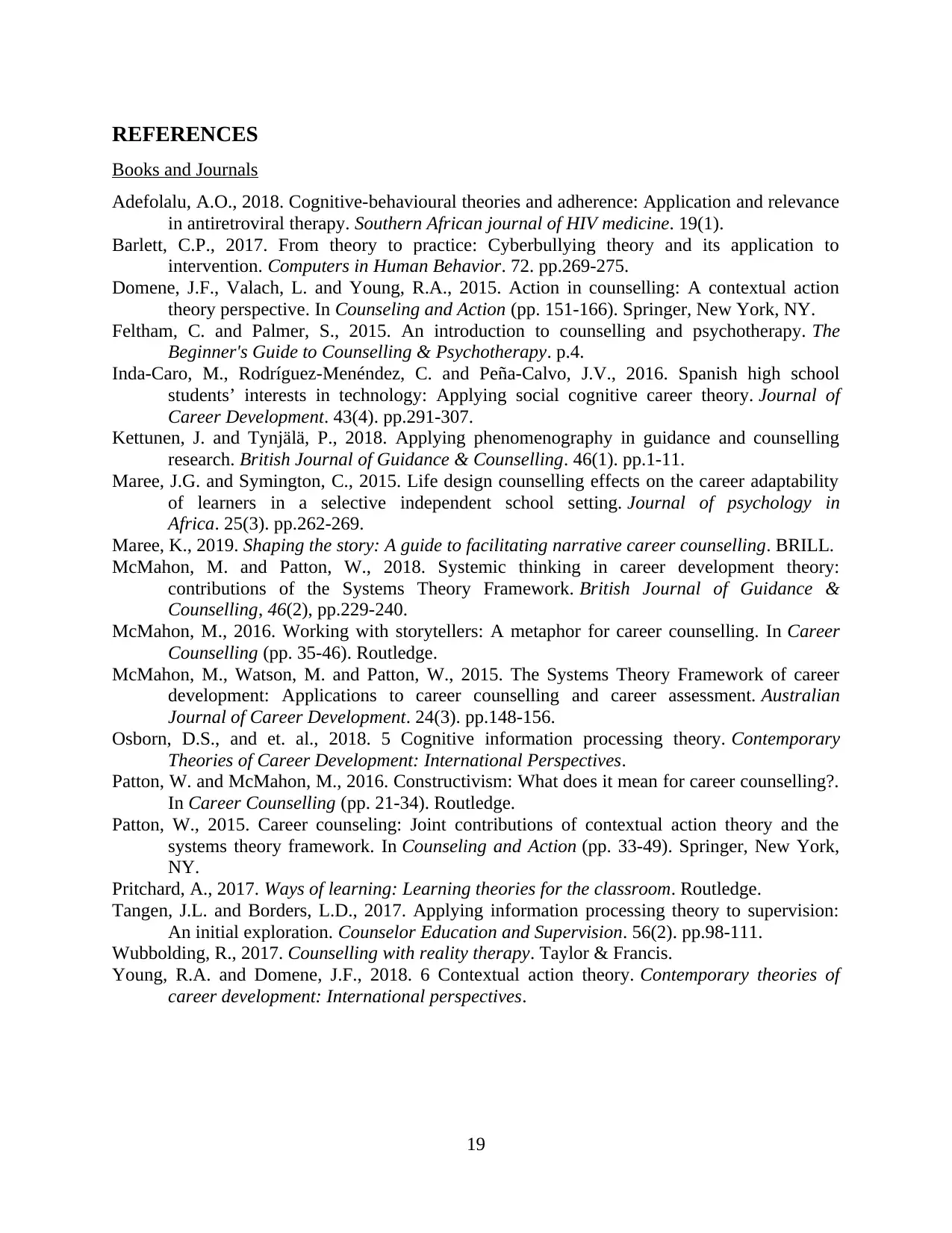
REFERENCES
Books and Journals
Adefolalu, A.O., 2018. Cognitive-behavioural theories and adherence: Application and relevance
in antiretroviral therapy. Southern African journal of HIV medicine. 19(1).
Barlett, C.P., 2017. From theory to practice: Cyberbullying theory and its application to
intervention. Computers in Human Behavior. 72. pp.269-275.
Domene, J.F., Valach, L. and Young, R.A., 2015. Action in counselling: A contextual action
theory perspective. In Counseling and Action (pp. 151-166). Springer, New York, NY.
Feltham, C. and Palmer, S., 2015. An introduction to counselling and psychotherapy. The
Beginner's Guide to Counselling & Psychotherapy. p.4.
Inda-Caro, M., Rodríguez-Menéndez, C. and Peña-Calvo, J.V., 2016. Spanish high school
students’ interests in technology: Applying social cognitive career theory. Journal of
Career Development. 43(4). pp.291-307.
Kettunen, J. and Tynjälä, P., 2018. Applying phenomenography in guidance and counselling
research. British Journal of Guidance & Counselling. 46(1). pp.1-11.
Maree, J.G. and Symington, C., 2015. Life design counselling effects on the career adaptability
of learners in a selective independent school setting. Journal of psychology in
Africa. 25(3). pp.262-269.
Maree, K., 2019. Shaping the story: A guide to facilitating narrative career counselling. BRILL.
McMahon, M. and Patton, W., 2018. Systemic thinking in career development theory:
contributions of the Systems Theory Framework. British Journal of Guidance &
Counselling, 46(2), pp.229-240.
McMahon, M., 2016. Working with storytellers: A metaphor for career counselling. In Career
Counselling (pp. 35-46). Routledge.
McMahon, M., Watson, M. and Patton, W., 2015. The Systems Theory Framework of career
development: Applications to career counselling and career assessment. Australian
Journal of Career Development. 24(3). pp.148-156.
Osborn, D.S., and et. al., 2018. 5 Cognitive information processing theory. Contemporary
Theories of Career Development: International Perspectives.
Patton, W. and McMahon, M., 2016. Constructivism: What does it mean for career counselling?.
In Career Counselling (pp. 21-34). Routledge.
Patton, W., 2015. Career counseling: Joint contributions of contextual action theory and the
systems theory framework. In Counseling and Action (pp. 33-49). Springer, New York,
NY.
Pritchard, A., 2017. Ways of learning: Learning theories for the classroom. Routledge.
Tangen, J.L. and Borders, L.D., 2017. Applying information processing theory to supervision:
An initial exploration. Counselor Education and Supervision. 56(2). pp.98-111.
Wubbolding, R., 2017. Counselling with reality therapy. Taylor & Francis.
Young, R.A. and Domene, J.F., 2018. 6 Contextual action theory. Contemporary theories of
career development: International perspectives.
19
Books and Journals
Adefolalu, A.O., 2018. Cognitive-behavioural theories and adherence: Application and relevance
in antiretroviral therapy. Southern African journal of HIV medicine. 19(1).
Barlett, C.P., 2017. From theory to practice: Cyberbullying theory and its application to
intervention. Computers in Human Behavior. 72. pp.269-275.
Domene, J.F., Valach, L. and Young, R.A., 2015. Action in counselling: A contextual action
theory perspective. In Counseling and Action (pp. 151-166). Springer, New York, NY.
Feltham, C. and Palmer, S., 2015. An introduction to counselling and psychotherapy. The
Beginner's Guide to Counselling & Psychotherapy. p.4.
Inda-Caro, M., Rodríguez-Menéndez, C. and Peña-Calvo, J.V., 2016. Spanish high school
students’ interests in technology: Applying social cognitive career theory. Journal of
Career Development. 43(4). pp.291-307.
Kettunen, J. and Tynjälä, P., 2018. Applying phenomenography in guidance and counselling
research. British Journal of Guidance & Counselling. 46(1). pp.1-11.
Maree, J.G. and Symington, C., 2015. Life design counselling effects on the career adaptability
of learners in a selective independent school setting. Journal of psychology in
Africa. 25(3). pp.262-269.
Maree, K., 2019. Shaping the story: A guide to facilitating narrative career counselling. BRILL.
McMahon, M. and Patton, W., 2018. Systemic thinking in career development theory:
contributions of the Systems Theory Framework. British Journal of Guidance &
Counselling, 46(2), pp.229-240.
McMahon, M., 2016. Working with storytellers: A metaphor for career counselling. In Career
Counselling (pp. 35-46). Routledge.
McMahon, M., Watson, M. and Patton, W., 2015. The Systems Theory Framework of career
development: Applications to career counselling and career assessment. Australian
Journal of Career Development. 24(3). pp.148-156.
Osborn, D.S., and et. al., 2018. 5 Cognitive information processing theory. Contemporary
Theories of Career Development: International Perspectives.
Patton, W. and McMahon, M., 2016. Constructivism: What does it mean for career counselling?.
In Career Counselling (pp. 21-34). Routledge.
Patton, W., 2015. Career counseling: Joint contributions of contextual action theory and the
systems theory framework. In Counseling and Action (pp. 33-49). Springer, New York,
NY.
Pritchard, A., 2017. Ways of learning: Learning theories for the classroom. Routledge.
Tangen, J.L. and Borders, L.D., 2017. Applying information processing theory to supervision:
An initial exploration. Counselor Education and Supervision. 56(2). pp.98-111.
Wubbolding, R., 2017. Counselling with reality therapy. Taylor & Francis.
Young, R.A. and Domene, J.F., 2018. 6 Contextual action theory. Contemporary theories of
career development: International perspectives.
19
1 out of 23
Related Documents
Your All-in-One AI-Powered Toolkit for Academic Success.
+13062052269
info@desklib.com
Available 24*7 on WhatsApp / Email
![[object Object]](/_next/static/media/star-bottom.7253800d.svg)
Unlock your academic potential
© 2024 | Zucol Services PVT LTD | All rights reserved.




